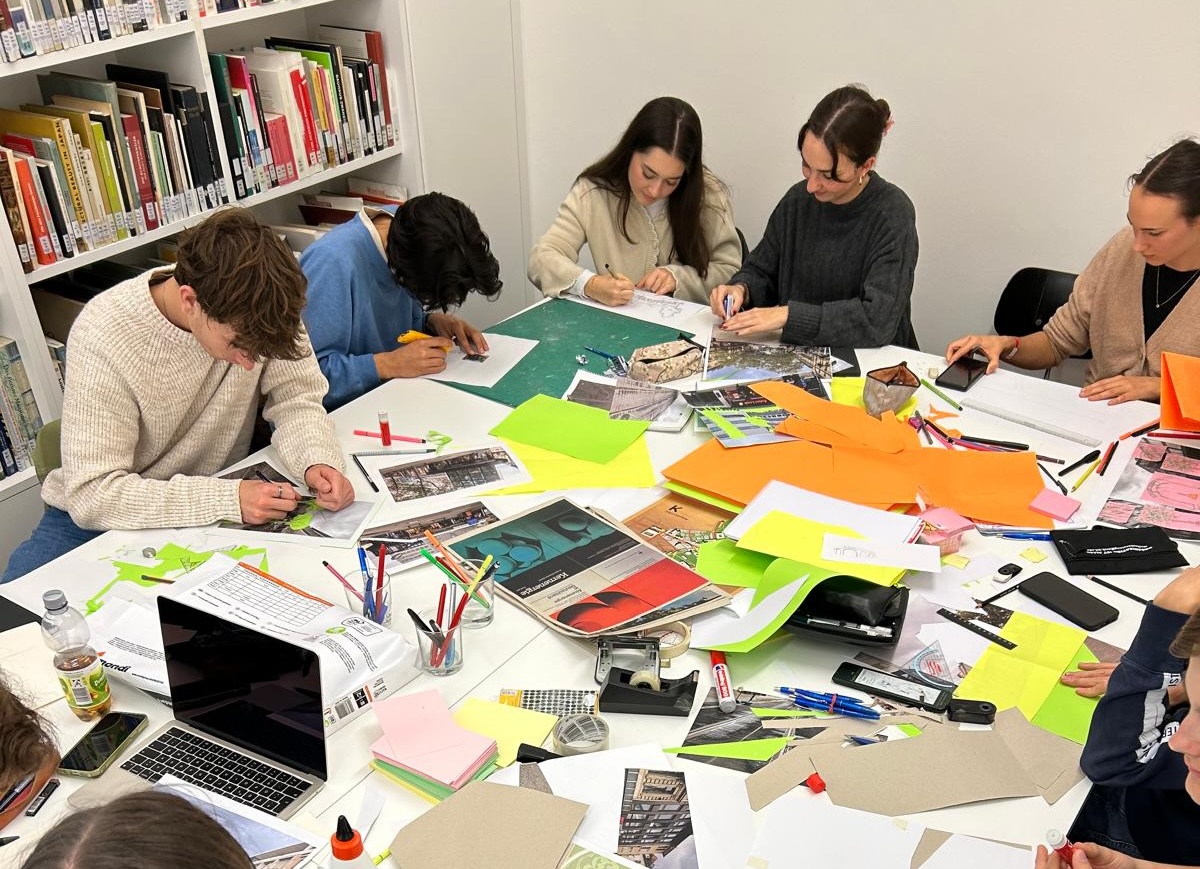BRASIL
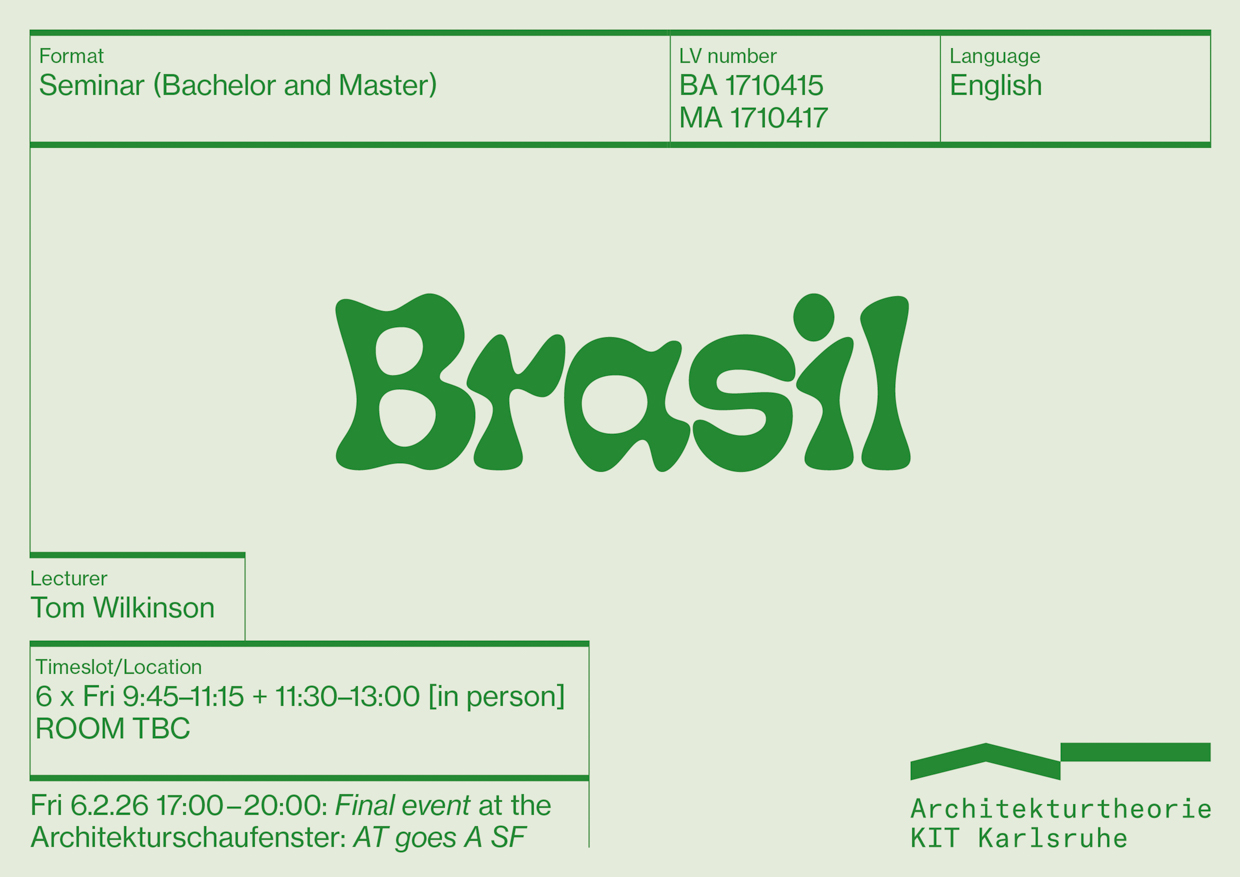
Tom Wilkinson
Die Theorie und Geschichtsschreibung der modernen Architektur, die lange Zeit auf den globalen Norden fokussiert war, beginnt sich zu dezentralisieren. Doch ein Land des globalen Südens spielte in dieser Geschichte trotz seiner vermeintlichen Randlage stets eine herausragende Rolle: Brasilien. In diesem Seminar diskutieren wir den Begriff „Nation“ als epistemologische Kategorie, Modelle relativer Entwicklung in der Architekturgeschichte und die theoretischen Beiträge, die sich aus den besonderen Bedingungen Brasiliens entwickelt haben: enorm in Ausmaß und Ungleichheit, geprägt von Kolonialismus, Diktatur, Einwanderung und Sklaverei.
LA
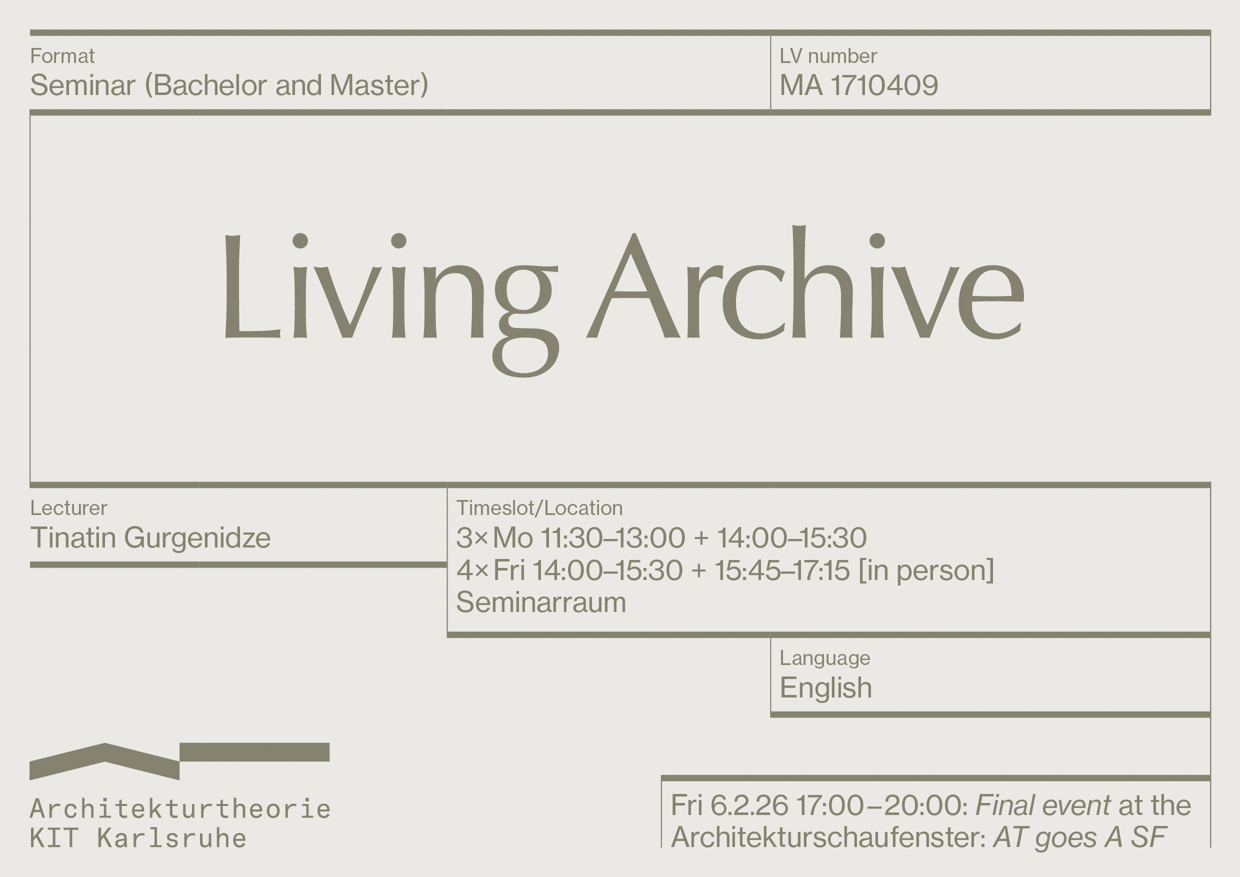
Tinatin Gurgenidze
Dieses Seminar wird architektonische Elemente wie Fassaden, Balkone, Fenster und Erdgeschosse untersuchen und sie nicht nur als funktionale Bestandteile, sondern auch als kulturelle, soziale und politische Symbole betrachten. Wir werden analysieren, wie diese Elemente im Laufe der Zeit neue Bedeutungen annehmen, lokale Identitäten, wirtschaftliche Bedingungen und größere historische Veränderungen widerspiegeln.
Der Fall Georgiens ist hierbei besonders aufschlussreich, da der Zerfall der Sowjetunion eine radikale Transformation der gebauten Umwelt auslöste. Die Privatisierung des Wohnraums ermöglichte es den Bewohner:innen, standardisierte Wohnblöcke individuell zu verändern, was zu selbst geschaffenen Modifikationen führte, die bis heute die urbane Identität prägen. Durch die Einbettung dieses Beispiels in einen breiteren architektonischen Diskurs wird das Seminar verdeutlichen, wie scheinbar alltägliche Details dynamische Veränderungsprozesse verkörpern und als lebendige Archive kollektiver Erfahrung fungieren können.
PD
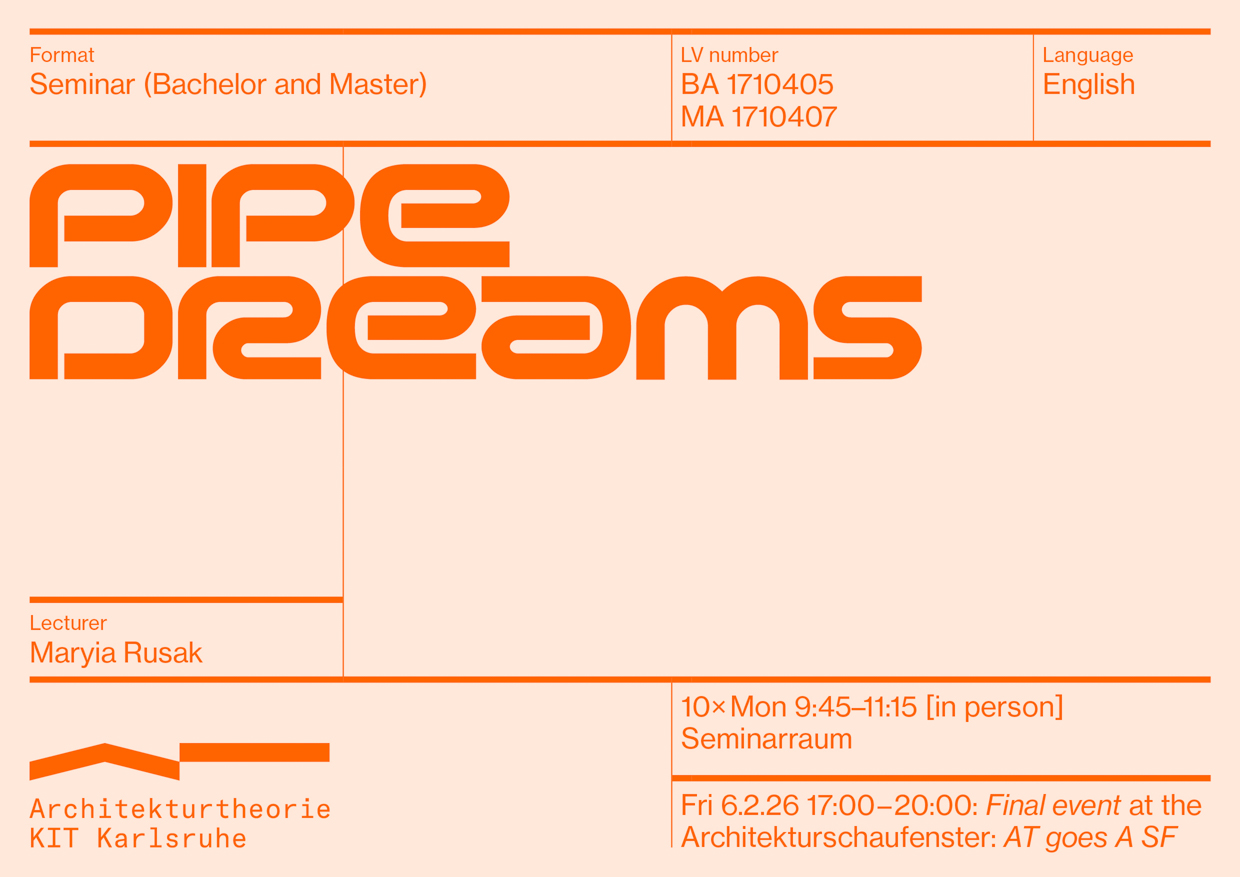
Maryia Rusak
Obwohl wir Raum oft als etwas Abstraktes begreifen, wird er durch eine Vielzahl infrastruktureller Systeme geprägt. Das Seminar untersucht, wie Infrastrukturnetze – Straßen, Eisenbahnen, Stromnetze, Ölpipelines, Internetkabel und Entsorgungssysteme – der abstrakten politischen Idee eines geeinten Europas eine konkrete physische Form verleihen. Besonderes Interesse gilt dabei der materiellen Beschaffenheit alltäglicher Infrastrukturobjekte und ihren generativen (und oft gewaltsamen) räumlichen Wirkungen.
Im Verlauf des Semesters lesen wir zentrale Texte zur Politik der Infrastruktur und analysieren politische Imaginationen ausgewählter Systeme. Karlsruhe, das in den 1970er-Jahren als europäischer Knotenpunkt für Öl und Daten entworfen wurde, dient dabei als Ausgangspunkt. Wir kartieren die räumlichen Auswirkungen ausgewählter Infrastrukturen und entwerfen alternative Zukünfte, die sensibler auf den gegenwärtigen Klimanotstand reagieren.
AAL
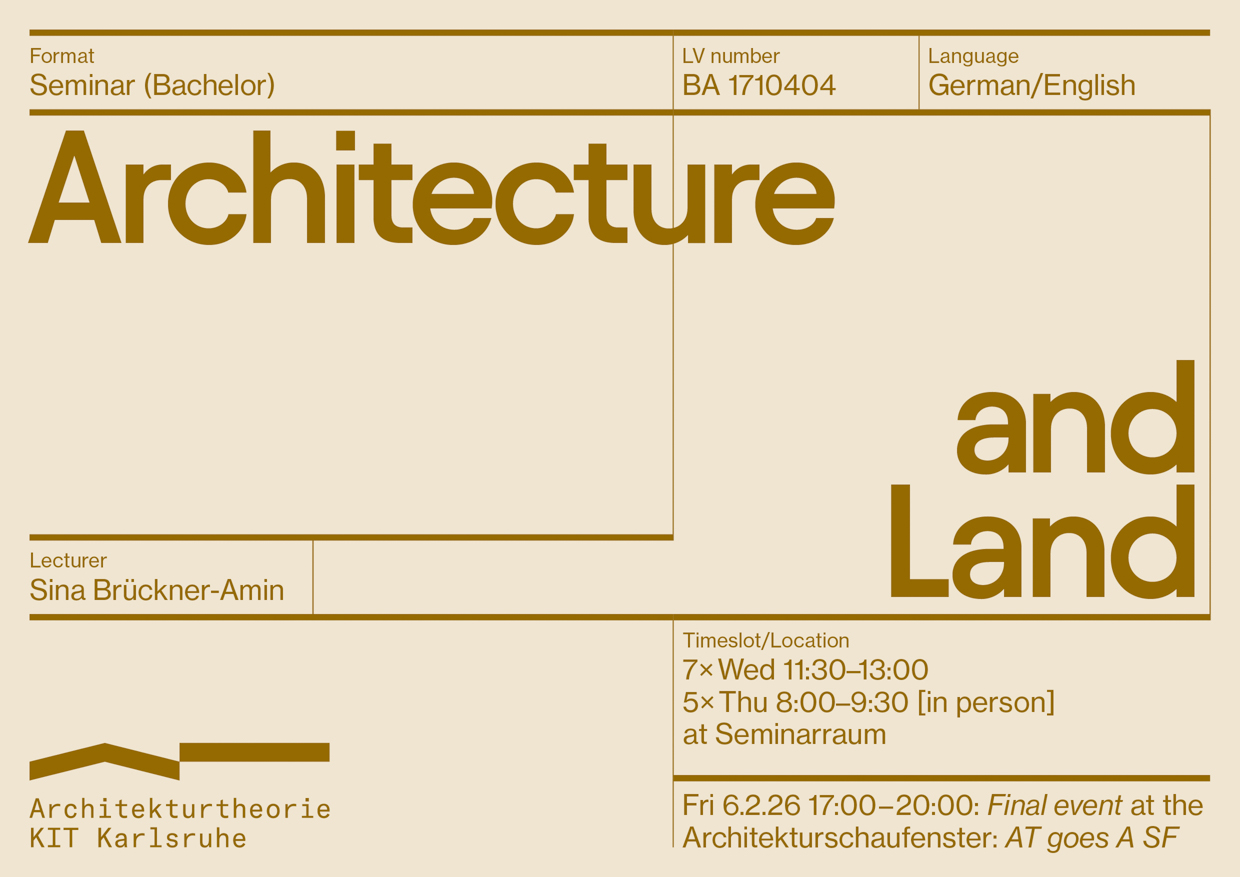
Sina Brückner-Amin
Architektur braucht Land – das ist eine der Grundvoraussetzungen für ihre Realisierung. Diese Selbstverständlichkeit führte dazu, dass „Land“ lange Zeit keine Entität war, die es überhaupt zu befragen galt. Über Jahrhunderte wurde sich Land selbstverständlich angeeignet, die damit komplex verknüpften Ressourcen kolonial ausgebeutet, und bestehende Ökosysteme von Nutzenden vernichtet, um Architekturproduktion zu ermöglichen. In diesem Seminar machen wir eine Reise um den Globus und in die Geschichte bis zur frühen Neuzeit, um die konkreten Mechanismen, Medien und Rhetoriken dieser Konsumption zu entschlüsseln. Das Seminar wird in deutscher Sprache stattfinden, die Lesematerialien werden in englischer Sprache bereitgestellt.
AOD
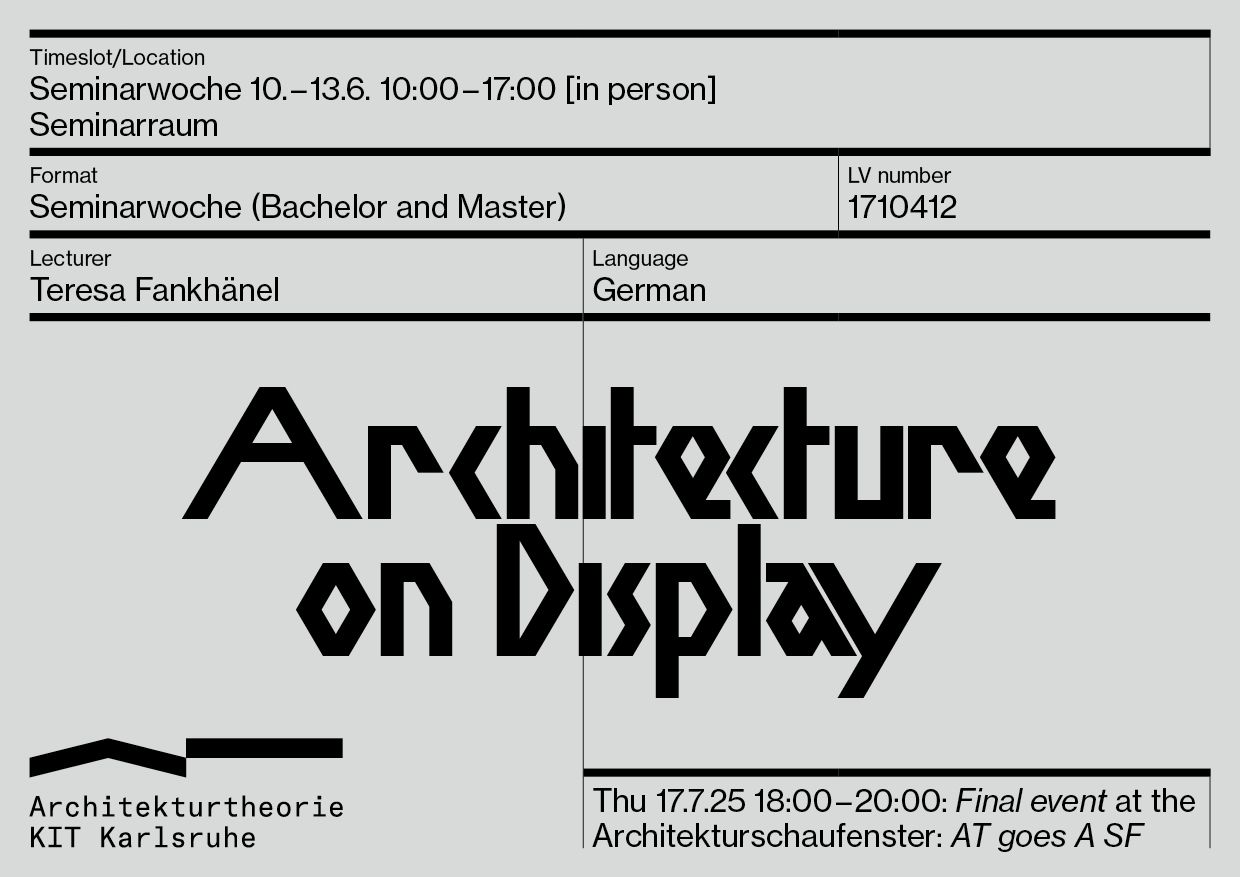
Teresa Fankhänel
Was zählt man in einem Archiv unter Architektur? Die diesjährige Seminarwoche wirft einen Blick auf den großen Nachlass an architektonischen Kinderbüchern, die im saai aufbewahrt werden und untersucht sie als physische Artefakte, als Träger architektonischer Bedeutung und als Ausstellungsstücke.
Die Studierenden erhalten Einblicke in Archivierungs- und Konservierungspraktiken und erarbeiten eine Entwurfsskizze, bei der eine Ausstellungsstrategie für Architekturbücher entwickelt werden soll.
MS
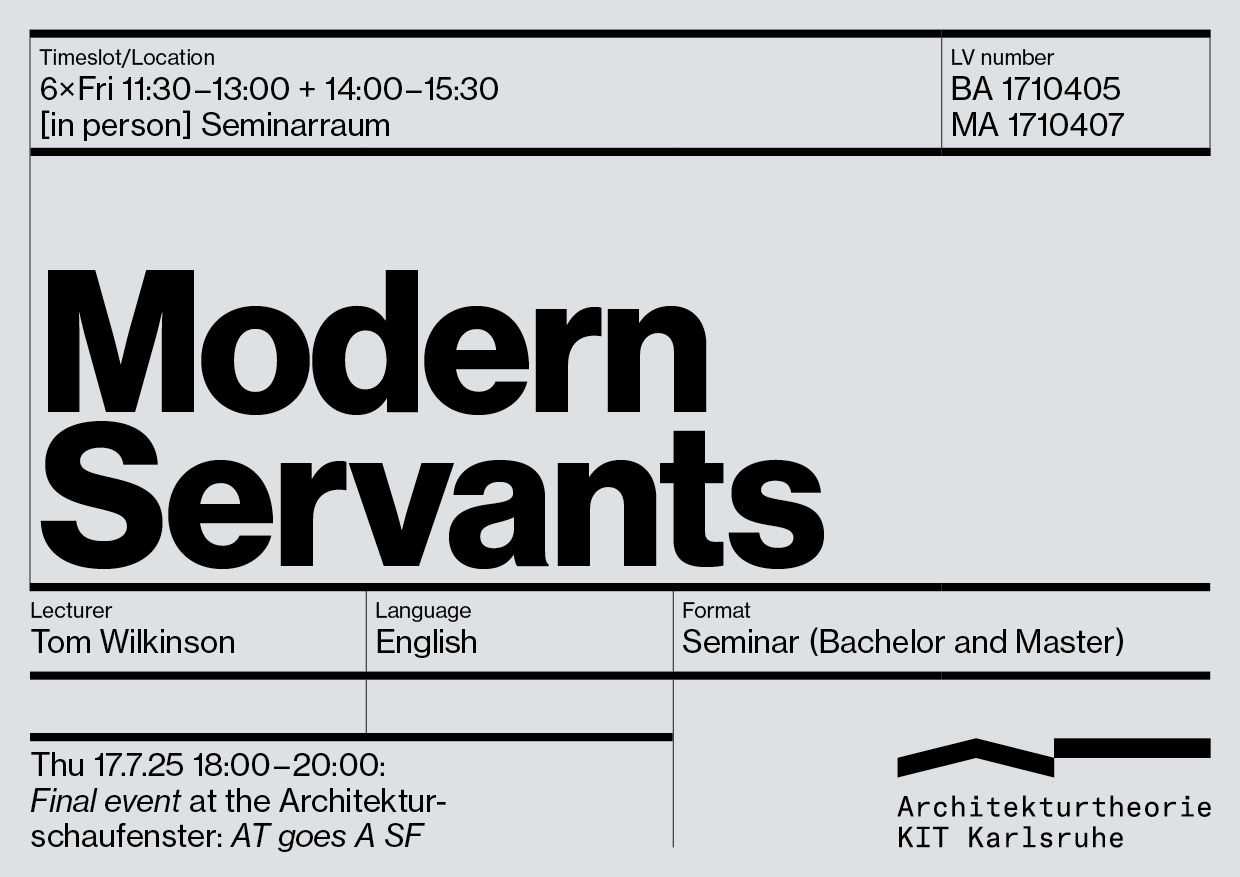
Tom Wilkinson
Modernistische Wohnungen wurden oft als Wohnmaschinen dargestellt, in denen neue Technologien mühsame Hausarbeit erleichtern. Tatsächlich wurden sie von Bediensteten geführt, denen verborgene Räume innerhalb dieser Gebäude zugewiesen wurden – eine Situation, die bis heute in vielen Ländern anhält. Wenn wir über diese Räume und ihre historischen Wurzeln im Feudalismus, Patriarchat und der Sklaverei nachdenken, können wir intersektionale Fragen über die Arbeit stellen, die die modernistische Architektur trägt, und über die Illusionen und Widersprüche der Moderne selbst.
AS:M
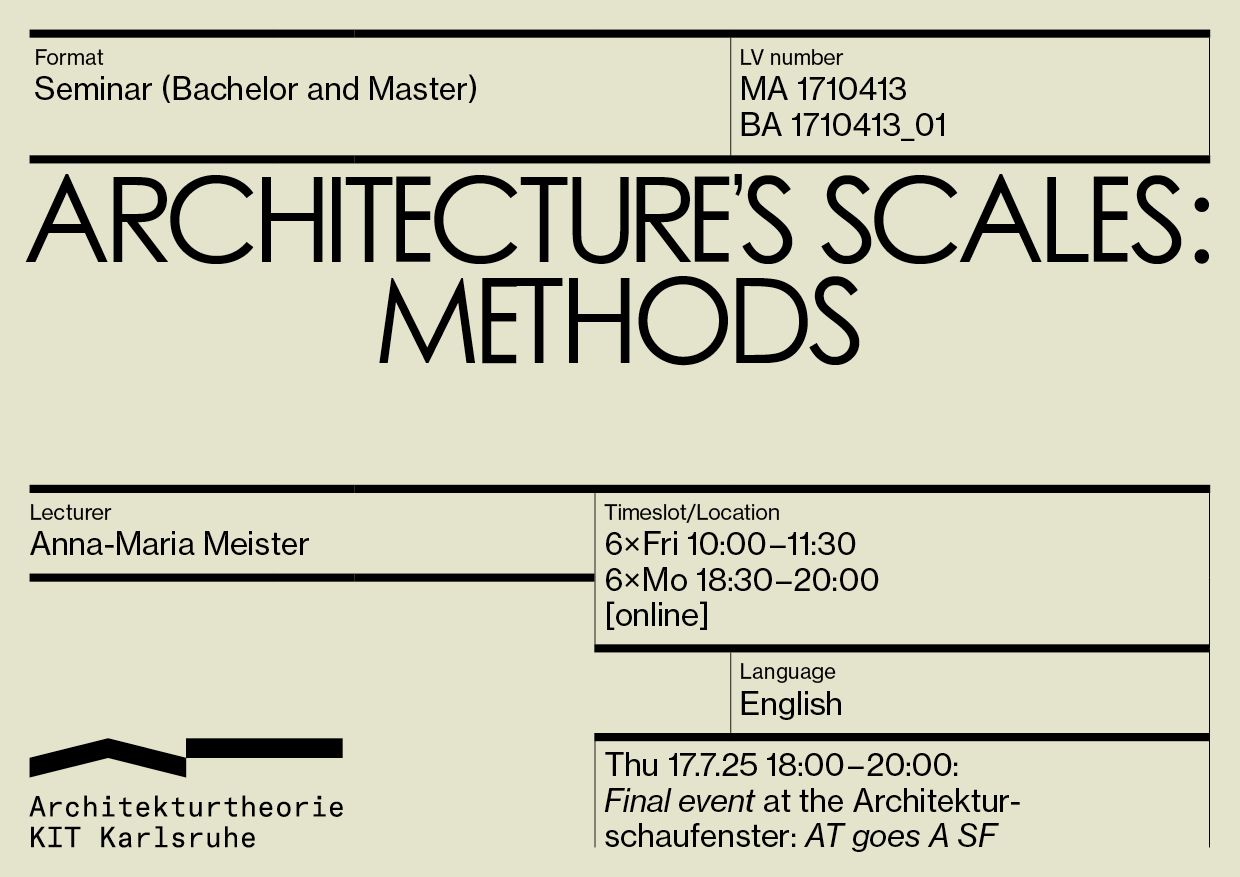
Anna-Maria Meister
Während die Archivarbeit die Grundlage für die historische Analyse bildet, ist das Schreiben von Geschichte eine Interpretationsarbeit. Wie wir schreiben, wirkt sich ebenso auf Geschichten und Erzählungen aus wie das, worüber wir schreiben. Wie kann man ein „Archiv“ finden und interpretieren? Wie kann man fehlendee Geschichten hinzufügen, wenn konventionelle Methoden sie nicht berücksichtigen konnten? In diesem Kurs werden wir sechs Methoden untersuchen: postkoloniale Studien, queere und feministische Studien, Alter-Geschichten und neuer Materialismus, globale Geschichte und ihre kritischen Überarbeitungen, Geomedien-Studien, mündliche Überlieferungen und kritische Fabulation. In sechs Doppelsitzungen werden wir einen Texte diskutieren, gefolgt von einer Abendvorlesung und Diskussion mit deren Autor*innen. Das Seminar wird in Zusammenarbeit mit Prof. Dr. Alla Vronskaya, Universität Kassel, und dem Kunsthistorischen Institut in Florenz in einem hybriden Format abgehalten und steht Bachelor-, Master- und Promovierenden offen.
CC UE
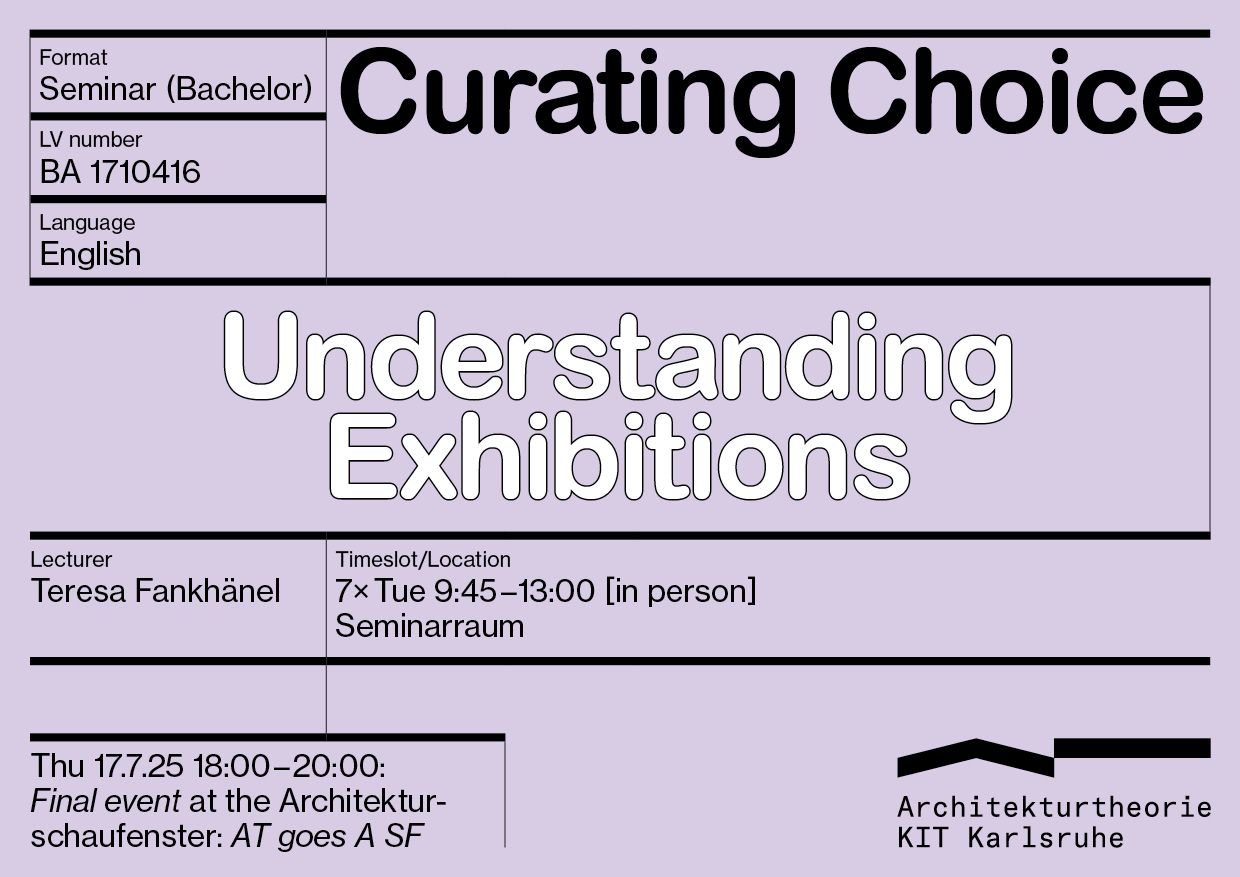
Teresa Fankhänel
Theorie besteht nicht nur aus schriftlichen Manifesten oder Büchern. Oftmals werden Ideen über andere Medien wie Gebäude, Fotos oder Ausstellungen vermittelt. Architekturausstellungen haben einen tiefgreifenden Einfluss auf die Art und Weise, wie wir mit über die gebauten Umwelt verhandeln. Ihren entscheidenden Einfluss auf die Architekturkultur zu entziffern, ist eine Schlüsselkompetenz für Architekt*innen.
Im vergangenen Semester haben wir uns mit dem Kanon historischer Ausstellungen befasst, nun werden wir ausgewählte Ausstellungen durch detaillierte Analysen untersuchen und uns durch einige der Schlüsselaspekte bewegen, die die Entstehung von Ausstellungen beeinflussen. Wir analysieren räumliche Techniken wie Rhythmus und Reihenfolge in Installationen, visuelle Strategien wie Sichtlinien und Organisationssysteme sowie kuratorische Konzepte und Besuchererfahrungen anhand einer genaueren Betrachtung ausgewählter Ausstellungsgrundrisse, Ansichten und schriftlicher Dokumente.
PAB TATOA
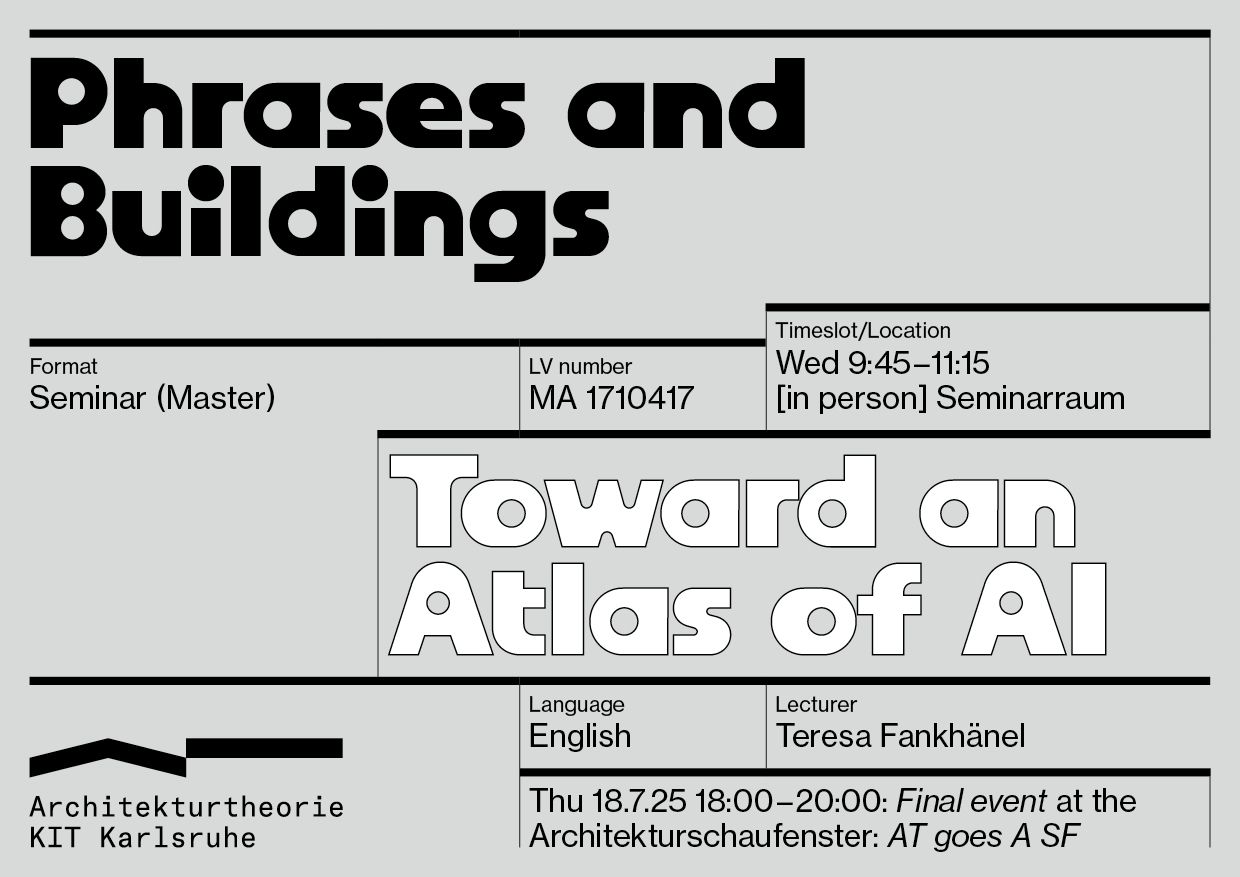
Teresa Fankhänel
Mit Large Language Models (LLMs) haben Computer gelernt, menschliche Sprache nachzuahmen. Anders als beim Menschen geschieht dieses Lernen jedoch nur mit Hilfe bereits vorhandener riesiger Sammlungen verarbeitbarer Daten, sei es in Form von Textquellen oder Bildern, die eine Extrapolation von Ähnlichkeiten und Konventionen ermöglichen. Um aus solchen Datenbanken mit Präzedenzfällen Bedeutung zu ziehen – um zu lernen – nutzen Maschinen von Menschen geschaffene Techniken. Ordnungssysteme wie Tags, Listen und Vergleiche unterliegen grundsätzlich der Verwendung von Sprache, von Metadaten bis hin zu automatisch abgeleiteten Alternativtexten.
In diesem Workshop-Seminar, das im Rahmen der Vorbereitung der Ausstellung „Stadt in der Cloud, Daten am Boden“ im Münchner Architekturmuseum ab Oktober 2025 stattfindet, geht es um die Rolle der menschlichen Sprache als Deskriptor in der Architektur.
P&CS
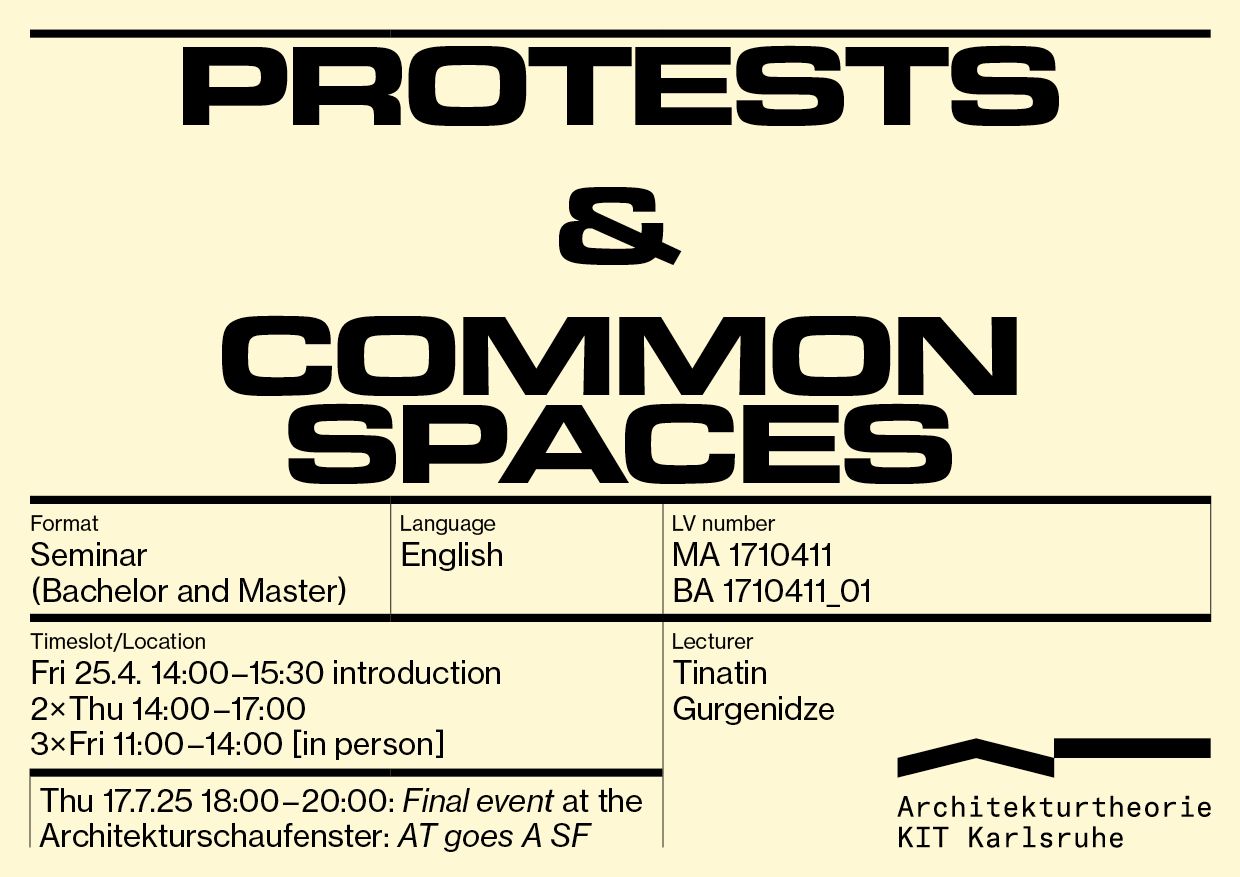
Tinatin Gurgenizide
Die jüngsten Wellen öffentlicher Proteste haben nicht nur den politischen Diskurs verändert, sondern auch die physische und soziale Struktur städtischer Räume und die Art und Weise, wie diese wahrgenommen werden. Dieses Seminar untersucht das Phänomen der Protestarchitektur und ihre Rolle bei der Rückeroberung städtischer Räume als Plattformen für Solidarität, Dialog und kollektives Handeln. Dabei werden Protestorte mit temporären Strukturen analysiert. Ziel der Untersuchung ist es, das Potenzial dieser Räume zu erforschen, die neoliberale Fragmentierung und Privatisierung städtischer Räume in Frage stellt. Die Analyse wird durch einen Rückblick auf die aktuellen Proteste in Tiflis sowie auf vergangene Proteste wie den Gezi-Park in Istanbul, den Tahrir-Platz in Kairo und den Maidan in Kiew unterstützt.
DIN FT
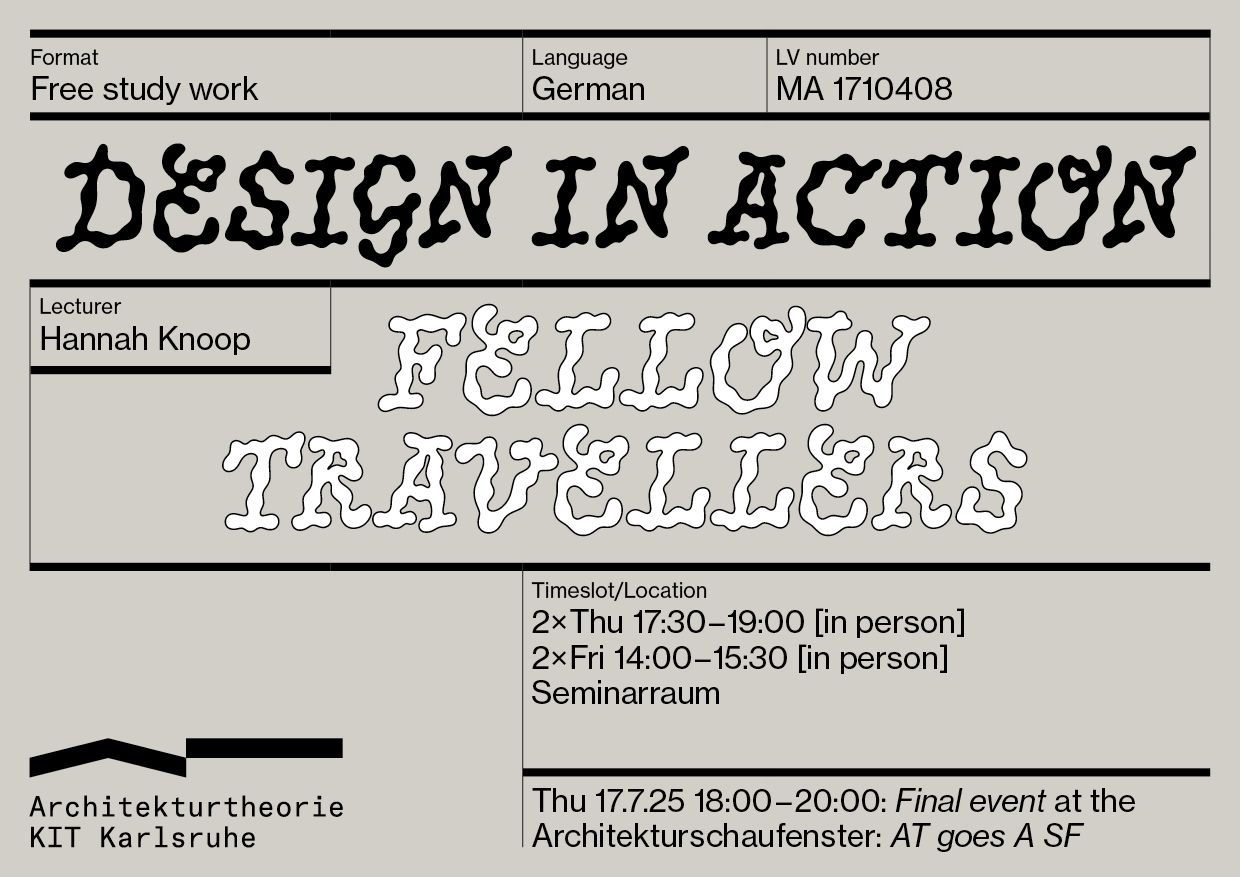
Hannah Knoop
In vergangenen Lehrveranstaltungen haben wir uns intensiv mit der Analyse von Krisen und Herausforderungen beschäftigt – nun richtet sich unser Fokus auf Lösungen! Mit Design in Action untersuchen wir konkrete Ansätze für gesellschaftlichen Wandel, inspiriert von Kulturtheorien (u.a. Bruno Latour) und der Ausstellung "Fellow Traveller"s im ZKM.
Die Ausstellung zeigt, wie Künstler:innen, Wissenschaftler:innen und Communities neue Wege des Zusammenlebens erproben. Es geht nicht nur um Kritik, sondern um Handeln: um Netzwerke jenseits traditioneller Machtzentren und Projekte, die Umwelt und Gesellschaft aktiv gestalten.
Die freie Studienarbeit umfasst 2 Diskussionstermine und 2 Museumsbesuche, bei denen jede:r ein Objekt vertieft betrachtet.
AG
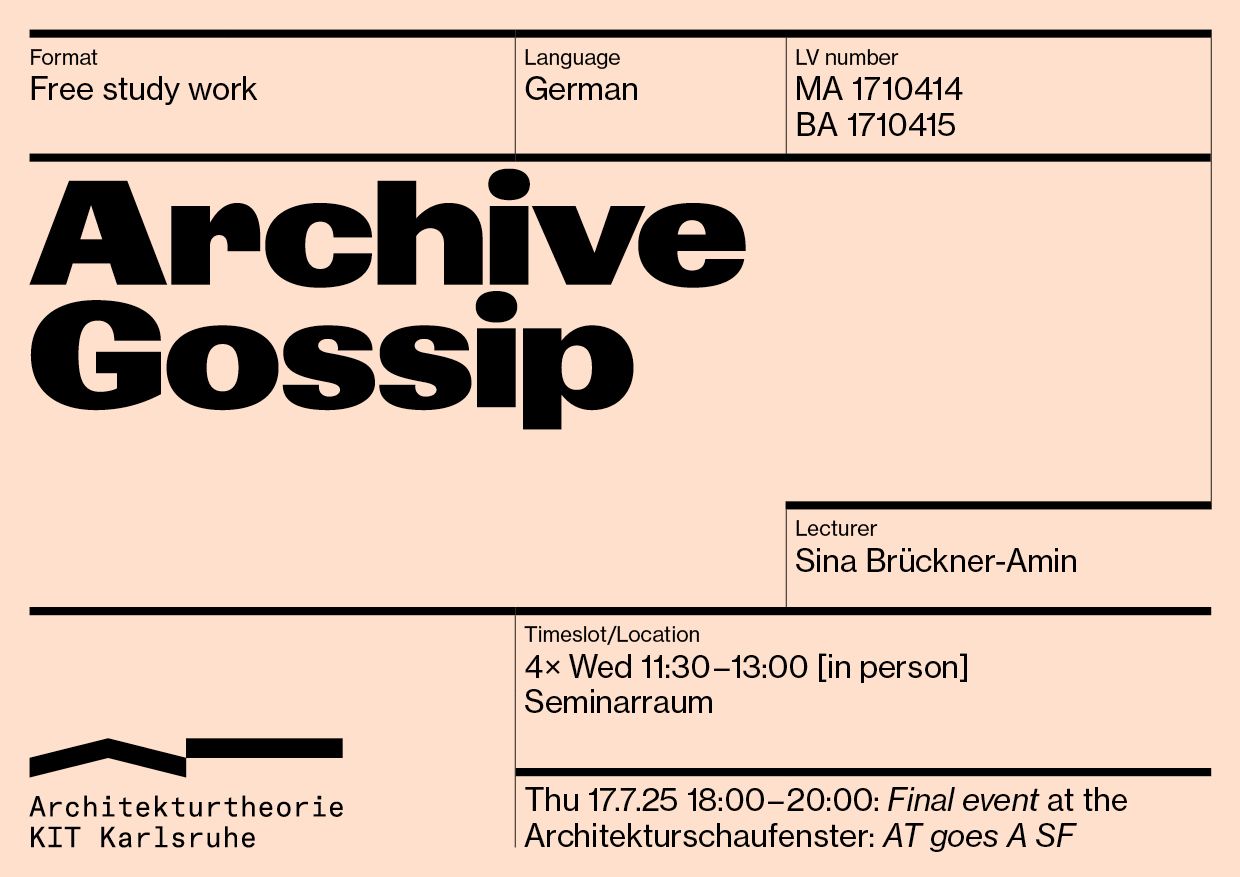
Sina Brückner-Amin
Auf der Suche nach „Archive Gossip“ erkunden wir das saai Archiv. Anhand ausgewählter Materialien widmen wir uns wenig erforschten Geschichten und Protagonist:innen. Das Ergebnis umfasst die Produktion von einer Podcastepisode. Wir befragen das kritische Potential von Gossip: Fragmentierte Quellen werden nur mit etwas Spekulation zu einer Geschichte konstruiert, aber wie gehen wir mit solchen Lücken um?
Dazu lesen wir Texte zum Archiv als Ort der Wissenskonstruktion um zu verstehen, wie Informationen in Dingen gespeichert werden und wie man sie wieder herauslesen kann. Wir wollen produktive Fragen an Archivmaterialien und Architekturmedien stellen und, darauf aufbauend, spannende und zugängliche Geschichten zu erzählen.
AD
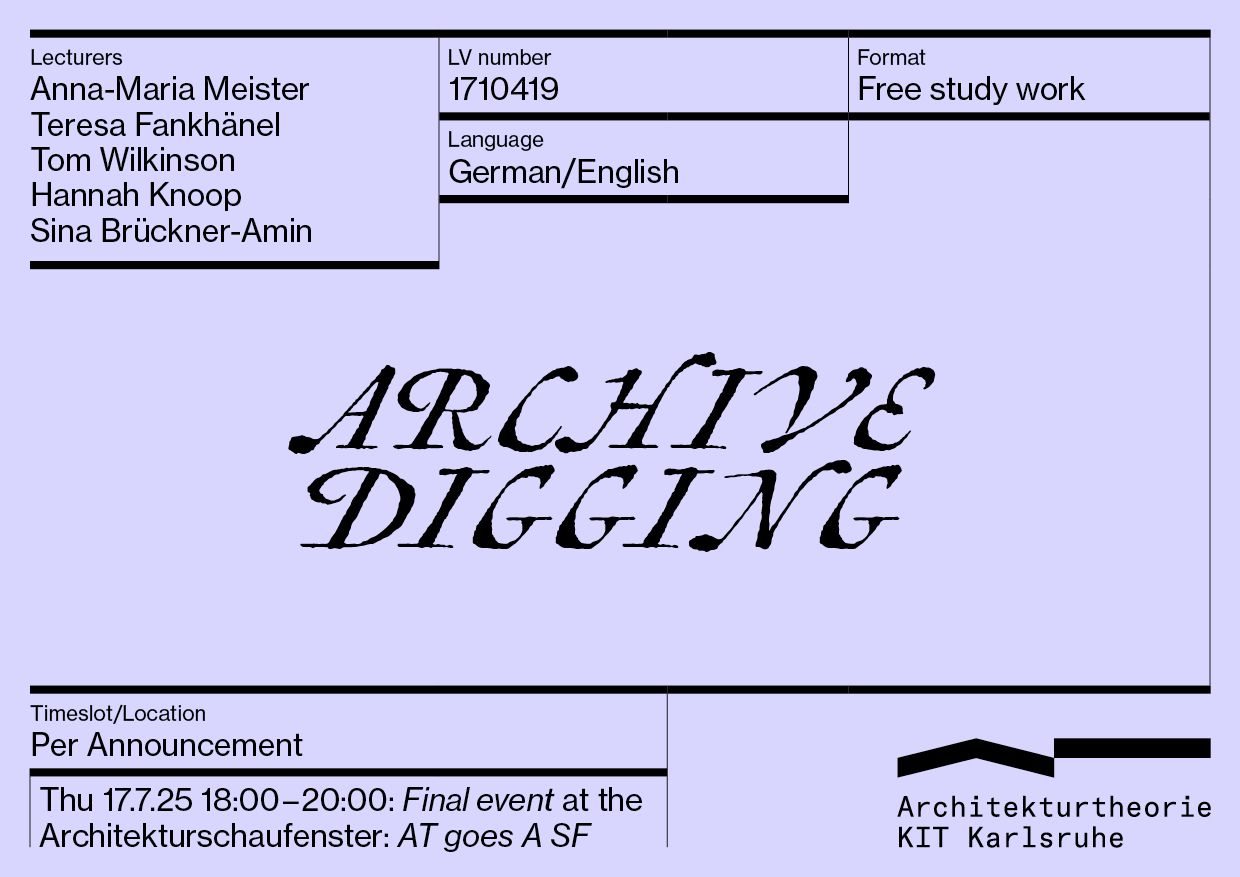
Anna-Maria Meister, Teresa Fankhänel, Tom Wilkinson, Hannah Knoop, Sina Brückner-Amin
Das saai Archiv ist eines der größten deutschen Architekturarchive - und es ist, wie viele Archive seiner Art, voller unerschlossener Nachlässe und Fehlstellen. In einem freien Forschungsprojekt kann Fragen nachgegangen werden, die sich mit Personen, Projekten, oder Archivstrategien befassen. Wer unterrichtete was genau am KIT als es noch nicht so hieß? Welche ephemeren Architekturen hat es in Karlsruhe schon gegeben, die ohne Spur wieder verschwanden? Wer hat eine Zeichnung angefertigt, und warum ist sie beschädigt? Solche und noch mehr Fragen können hier zusammen mit dem saai Team untersucht werden.
TITTS!
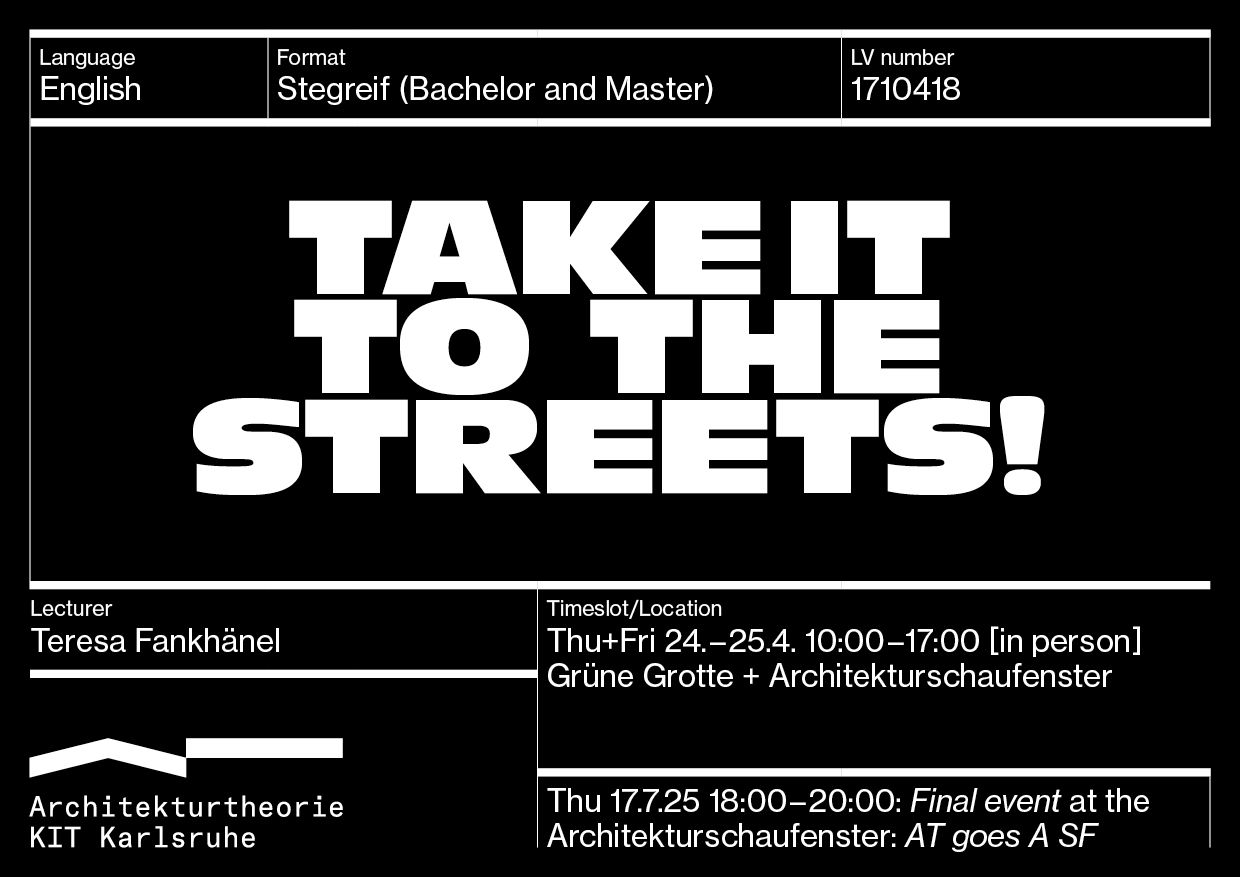
Im Gegensatz zur Architekturfotografie steht nicht das perfekt inszenierte, über-ästhetisierte Gebäude im Zentrum der Aufmerksamkeit der Street Photography. Sie thematisiert Stadt in ihrem alltäglichen Erscheinungsbild und im Zusammenspiel mit den Menschen, die sich darin bewegen. Der Stegreif in Zusammenarbeit mit dem Architekturschaufenster Karlsruhe lädt Studierende ein, einen ganz eigenen Blick auf die Stadt zu werfen.
CA
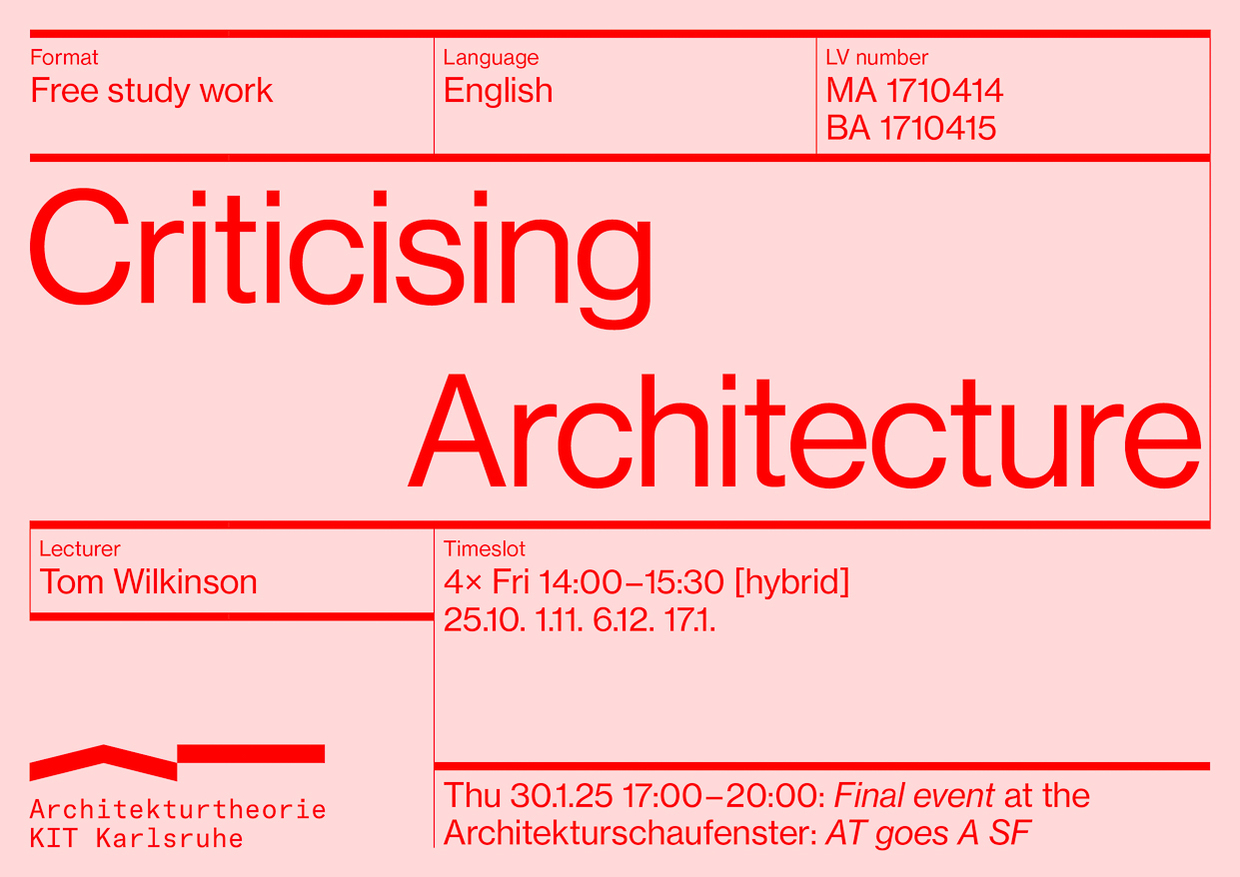
Tom Wilkinson
In diesem Forschungsseminar werden wir uns mit der Rolle der Kritik in der Architektur befassen: was es bedeutet, kritisch zu sein, wie Kritik als professionelle Praxis funktioniert, welche Beziehung die Kritik zum Design hat und was Kritik heute leisten kann. Wir werden einige Schlüsselbeispiele lesen und analysieren sowie einige theoretische Überlegungen zu dieser Form anstellen und anschließend selbst eine kurze Kritik verfassen.
CMBI?
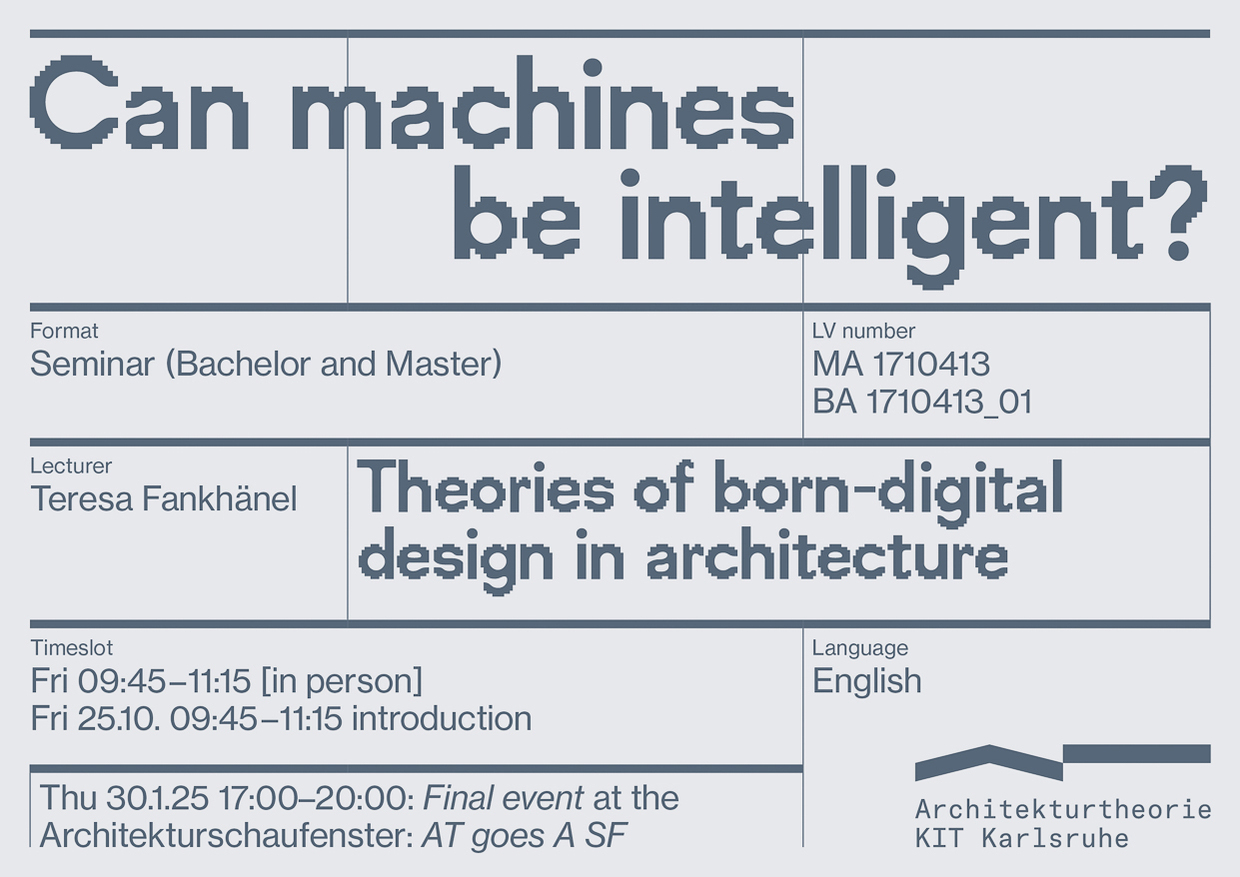
Teresa Fankhänel
In welche Richtung entwickelt sich das Entwerfen in einem sich schnell verändernden Zeitalter von Softwareimperien, künstlicher Intelligenz und Virtualität? Dieses Seminar beleuchtet die Ursprünge der heutiger digitaler Designphilosophien und ihrem Einfluss auf das architektonische Denken: von partizipativem Design und intelligenten computergestützten Designassistenten über ein erweitertes Feld generativer Geometrien bis hin zur Entstehung webbasierter interaktiver Plattformen. Schlüsseltexte und ausgewählte Fallstudien von den 60er Jahren bis heute untersuchen den Einfluss von Software, Computern und Internet auf die Gestaltung von Architektur und das architektonische Denken in der Gesellschaft insgesamt.
ExA
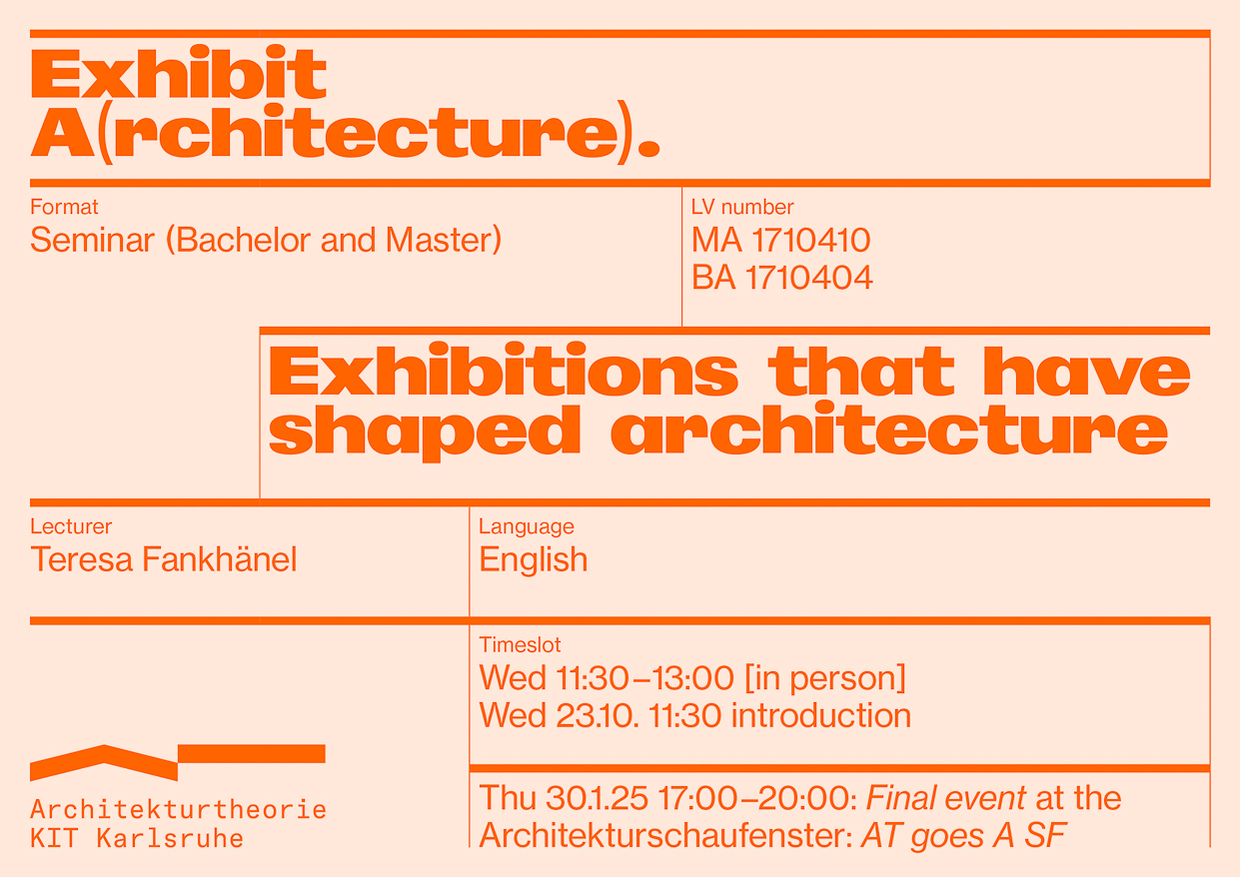
Teresa Fankhänel
Theorie besteht nicht nur aus schriftlichen Manifesten oder Büchern. Oftmals werden Ideen über andere Medien wie Gebäude, Fotos oder Ausstellungen vermittelt. Ihren entscheidenden Einfluss auf die Architekturkultur zu entziffern, ist eine Schlüsselkompetenz für Architekt*innen. Architekturausstellungen haben einen tiefgreifenden Einfluss auf die Art und Weise, wie wir mit über die gebauten Umwelt verhandeln. Während einige ganze Architekturströmungen begründet haben (International Style, MoMA, 1932 oder Biennale von Venedig, 1980), haben andere das Erbe einzelner Architekten im Kanon großer Architektur fest verankert. Das Seminar beleuchtet eine ausgewählte Anzahl von Ausstellungen, die das Verhältnis der Architektur zu Stilen und Moden, zu technischen Neuerungen, zum Verhältnis des Menschen zur Natur, zu Nationalität, Kultur und Globalisierung, zum Verhältnis des Einzelnen zur Gesellschaft und unser Verhältnis zur Geschichte geprägt haben.
LA!
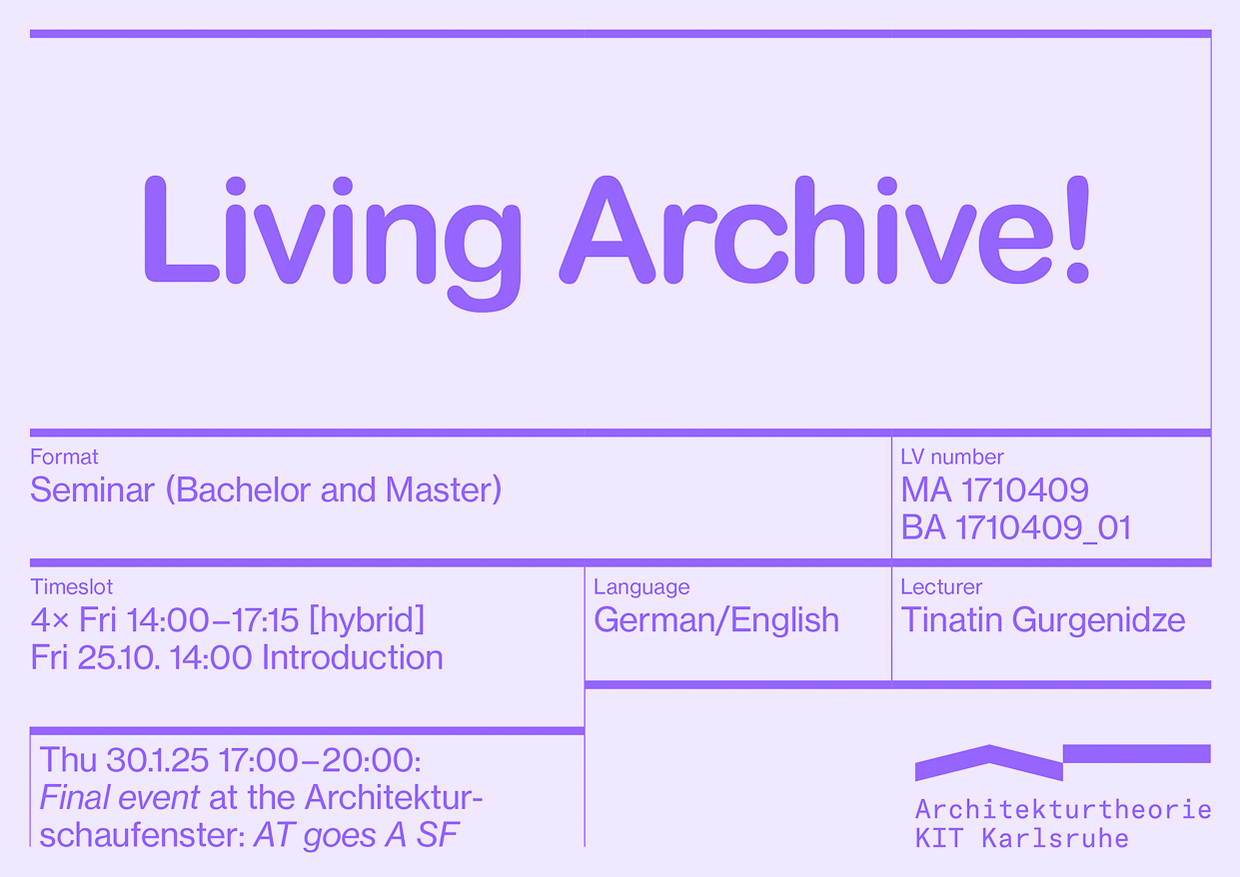
Tinatin Gurgenidze
Dieser Kurs erforscht die Transformation des Plattenbaus in der Übergangsphase von der Plan- zur Marktwirtschaft im postsowjetischen Georgien, vor allem in den späten 1990er bis zu den frühen 2000er Jahren. Die Entstehung neuer architektonischer Elemente in postsowjetischen Kontexten ist ein interessantes Untersuchungsgebiet. Dazu gehört die Dokumentation eines „lebenden Archivs“ durch die Visualisierung und Analyse der verschiedenen Typologien dieser transformierten Räume. Besonders hervorzuheben sind die bestehenden Typologien selbst gebauter Strukturen wie Balkone, Erdgeschosse, Anbauten und Garagen, um nur einige zu nennen, die den Fachleuten als greifbares Zeugnis der architektonischen Entwicklung dieser Zeit dienen. Der geplante Kurs zielt darauf ab, das „lebende Archiv“ zu erforschen, zu analysieren und zu dokumentieren.
RBB
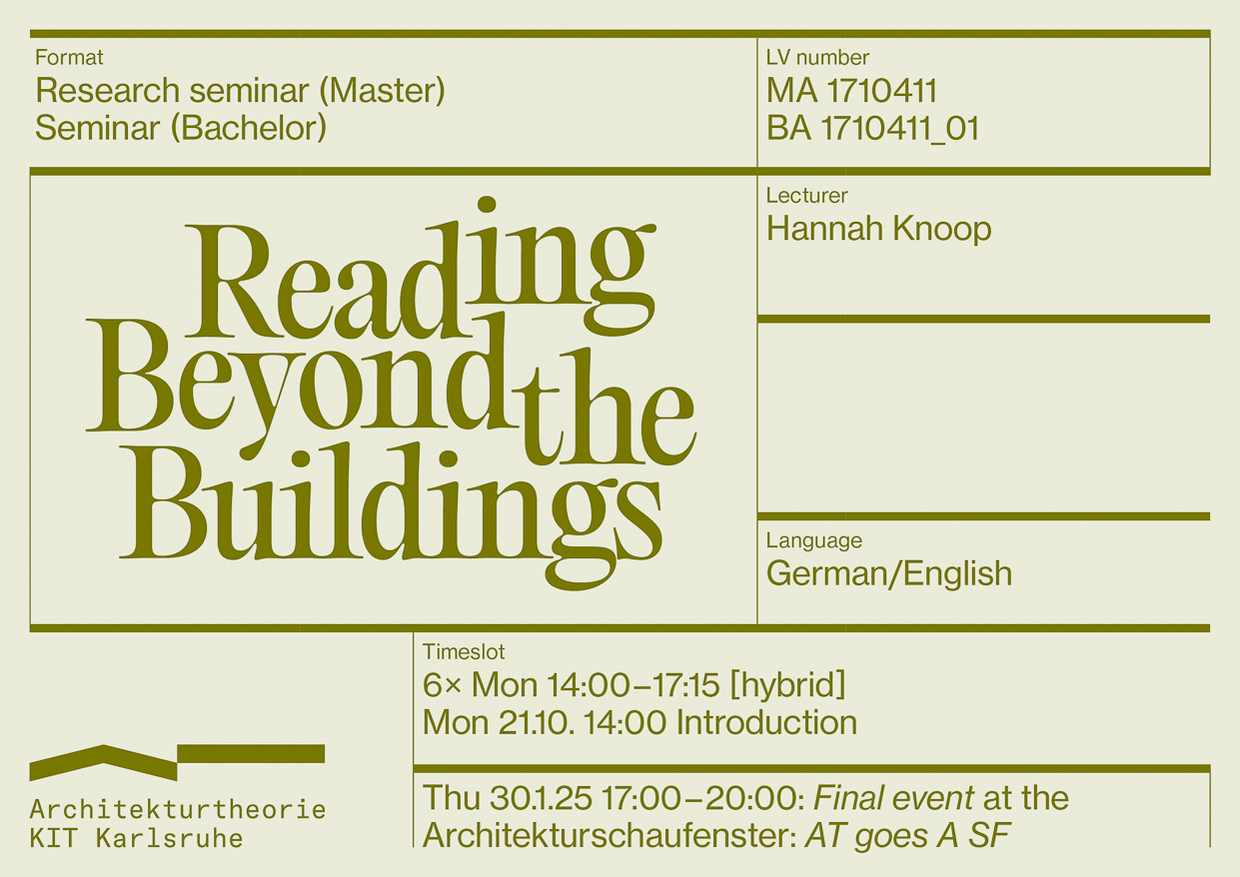
Hannah Knoop
Architektur und städtischer Raum sind Teil einer Infrastruktur politischer Teilhabe und rechtlicher Zugehörigkeit, etwa durch die Organisation und ästhetische Prägung des öffentlichen Raums sowie kultureller und politischer Institutionen. Nach dem 2. Weltkrieg erhielt die Architekturdisziplin von den Vereinten Nationen die Aufgabe, nicht nur Wohnungsprobleme zu lösen, sondern auch in internationalen Beziehungen zu wirken. Damit begann auch eine Auseinandersetzung mit architektonischen Schauplätzen von Kolonialismus, Menschenrechtsverletzungen oder Diskriminierung. Wie war und ist die Disziplin daran beteiligt oder verantwortlich? Welche Positionen nimmt sie heute ein? Basierend auf Texten aus Architekturtheorie, Politikwissenschaft und Post-Colonial-Studies wollen wir im Forschungsseminar 'über die Gebäude hinaus lesen' und recherchieren.
R:IKL
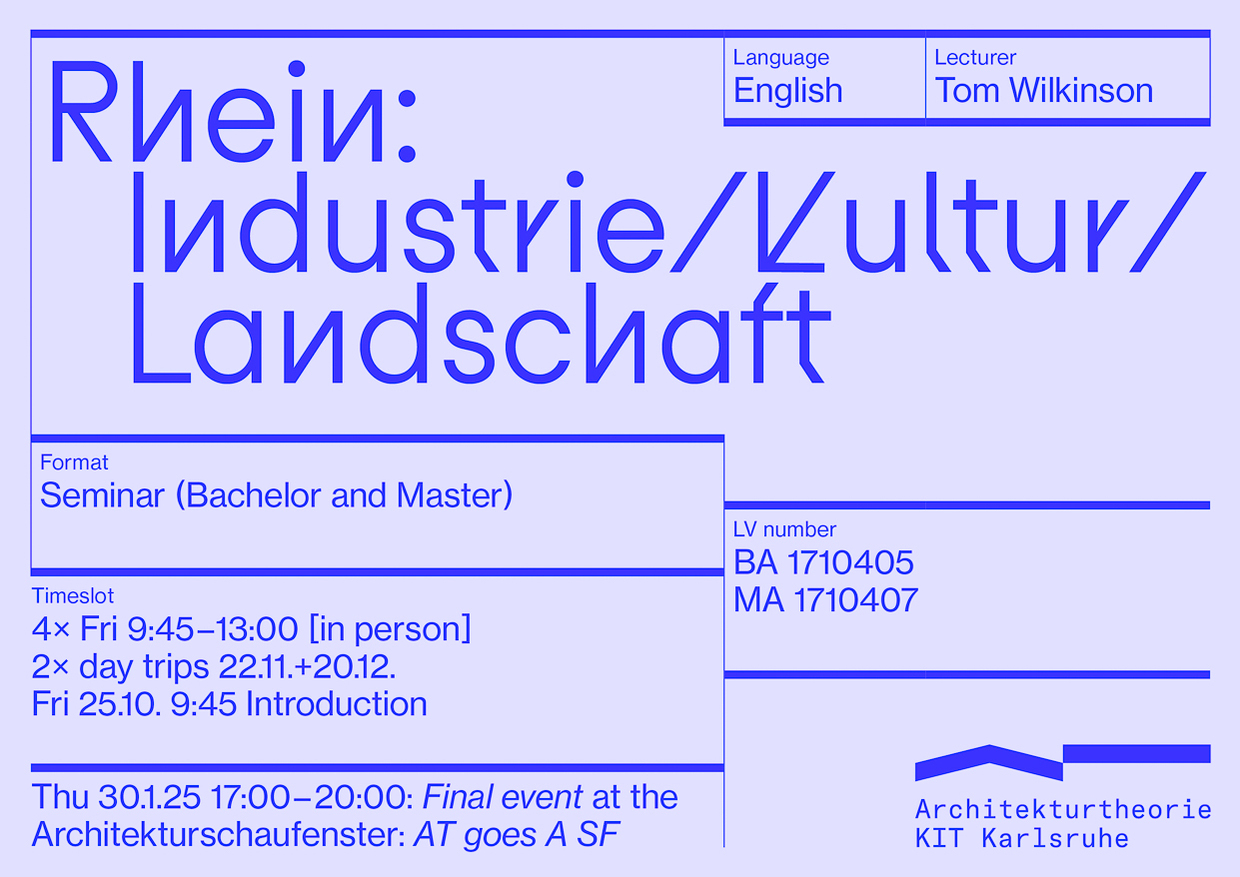
Tom Wilkinson
Der Rhein ist einer der wichtigsten Flüsse Europas, ein lebenswichtiger Wirtschaftsweg, der Menschen und Güter zwischen den großen Städten transportiert, ein geografisches Merkmal, das den Kontinent - und die Welt - verbindet und trennt. Er ist auch eine Kulturlandschaft, die eine zentrale Rolle bei der Entwicklung der modernen deutschen Identität gespielt hat. Doch der moderne Fluss ist dank der Kanalisierung kaum noch natürlich - er ist eines der größten Infrastrukturprojekte der Welt. Seit der industriellen Revolution leidet er zudem unter starker Verschmutzung, und nun droht der Klimawandel, ihn unbefahrbar zu machen. In diesem Forschungsseminar werden wir wichtige Schauplätze besuchen und Texte von Dichter*innen, Designer*innen, Philosoph*innen und Geograph*innen lesen. Wir werden den Rhein und seine Architektur nutzen, um größere Fragen über Natur und Design, Wirtschaft und Kultur zu untersuchen.
AT goes A SF
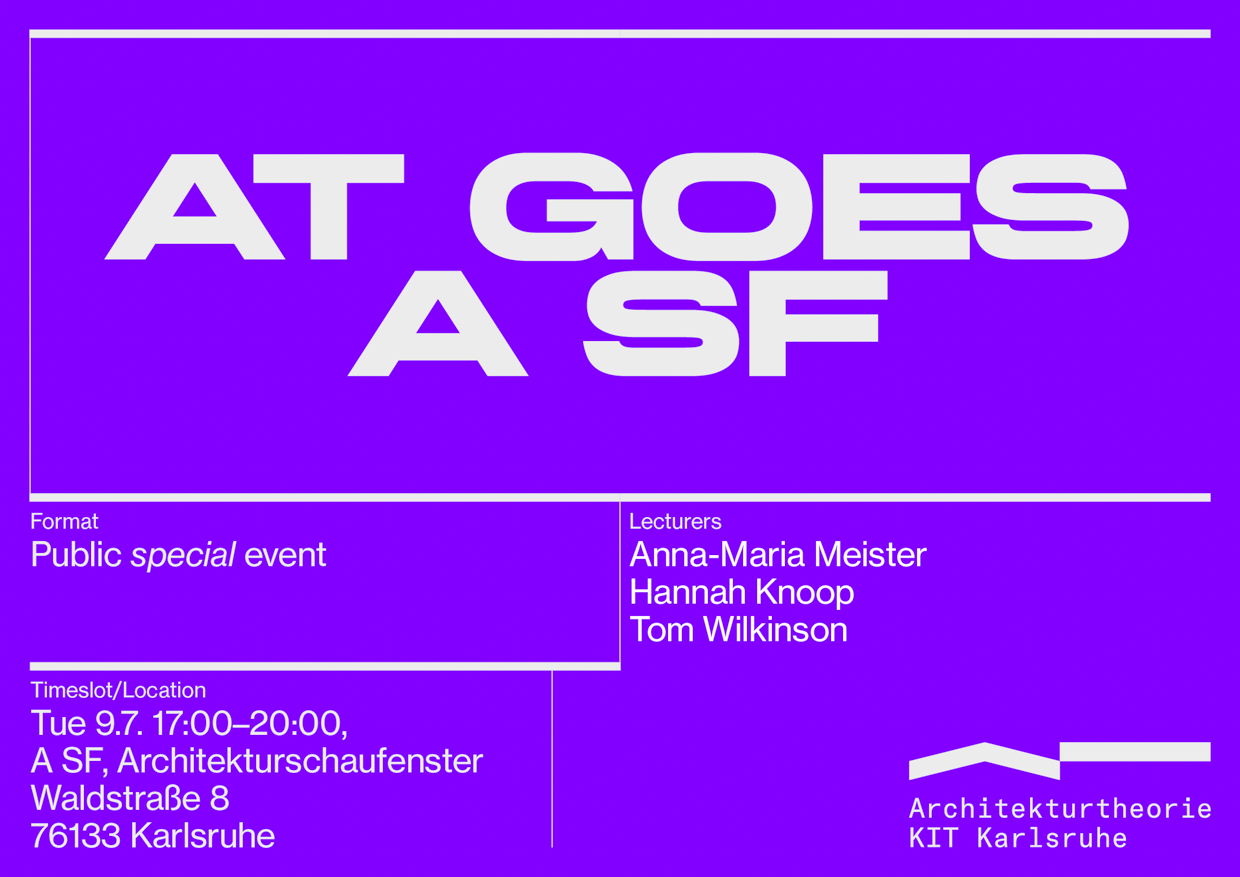
Anna-Maria Meister, Hannah Knoop, Tom Wilkinson
Wir wollen Architekturtheorie greifbar machen, in dem wir sie ausstellen, gemeinsam diskutieren und im Karlsruher Stadtraum zeigen! Dafür laden wir wieder ins Architekturschaufenster zu „AT goes A SF“ ein: ein Abend, an dem wir Erkenntnisse, Fragen und Ideen aus unseren Lehrveranstaltungen mit Studierenden und Gästen diskutieren wollen. Dabei bewegen wir uns durch diverse Maßstäbe, Kategorien und Kontexte: wir erarbeiten Schlüsselbegriffe der Architekturtheorie, lesen Kritische Theorie, untersuchen die verschiedenen Maßstäbe architektonischer Objekte, setzen uns mit der Kultur der Badeeinrichtungen auseinander, analysieren Architekturen der politischen Entscheidungsfindung und gehen in den Bundesgerichtshof, und forschen in florentinischen Archiven. Architekturtheorie verstehen wir dabei als verbindende kritische Praxis – und freuen uns auf lebhaften Austausch!
ADM
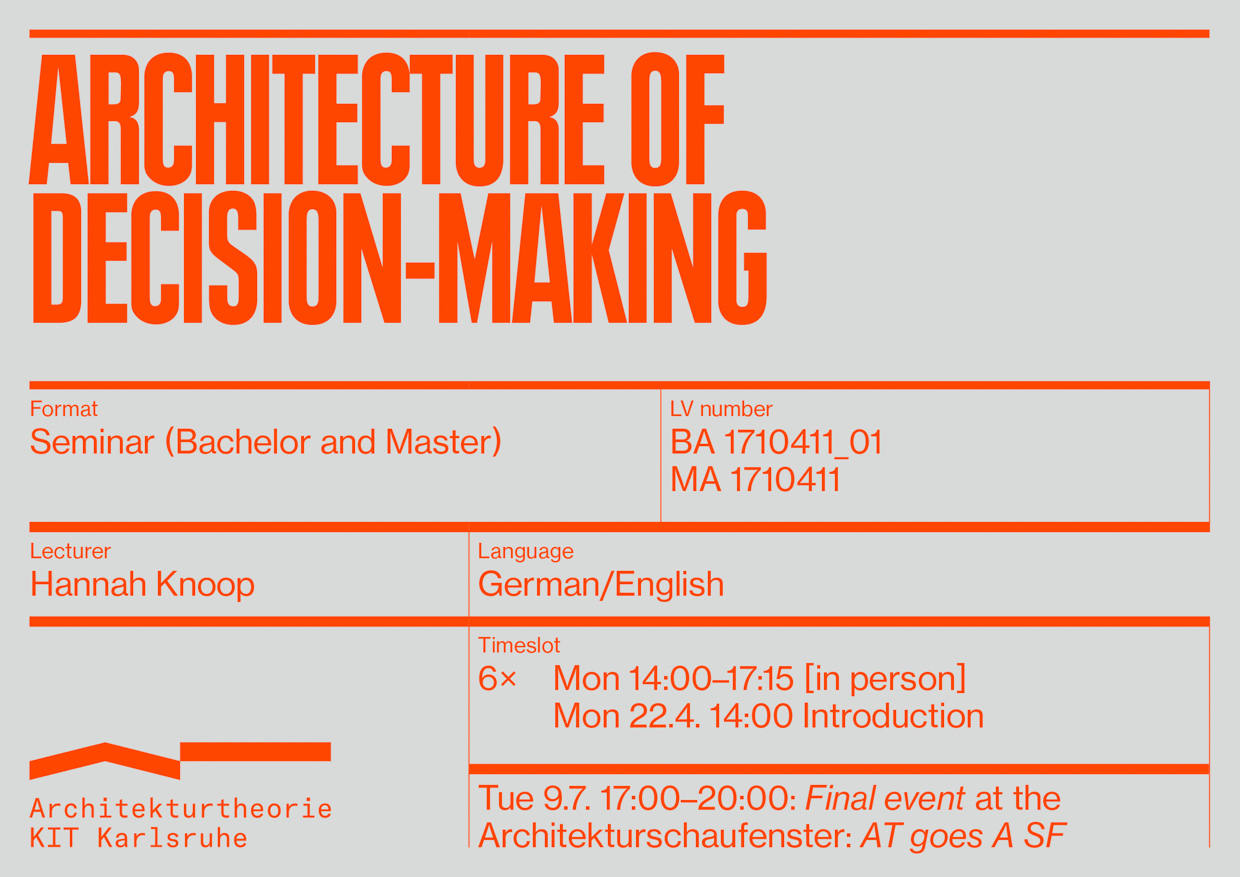
Hannah Knoop
Fassaden, Portale und Versammlungshallen sind architektonische Symbole der politischen Entscheidungsfindung und Macht. Dabei werden Nebenräume, Möbel und Raumkonfigurationen oft übersehen. Doch gerade in langen Fluren, an runden Tischen oder vor festinstallierten Fernsehkameras werden politisch brisante Entscheidungen diskutiert, getroffen und verkündet.
Wie hängen diese Räume und Objekte mit politischen Systemen zusammen? Welche Macht kann von Ihnen ausgehen? Diese und andere Fragen sollen mit Hilfe architekturtheoretische Texte zu Macht und Architektur, der Analyse von Fallbeispielen sowie in einem Stegreif-Entwurf erörtert werden.
Die Veranstaltung ist als Lektüre- und Rechercheseminar konzipiert. Der Stegreif (MA-Arch) ist obligatorisch.
Take a Seat and make your Decision comfortably!
ASO
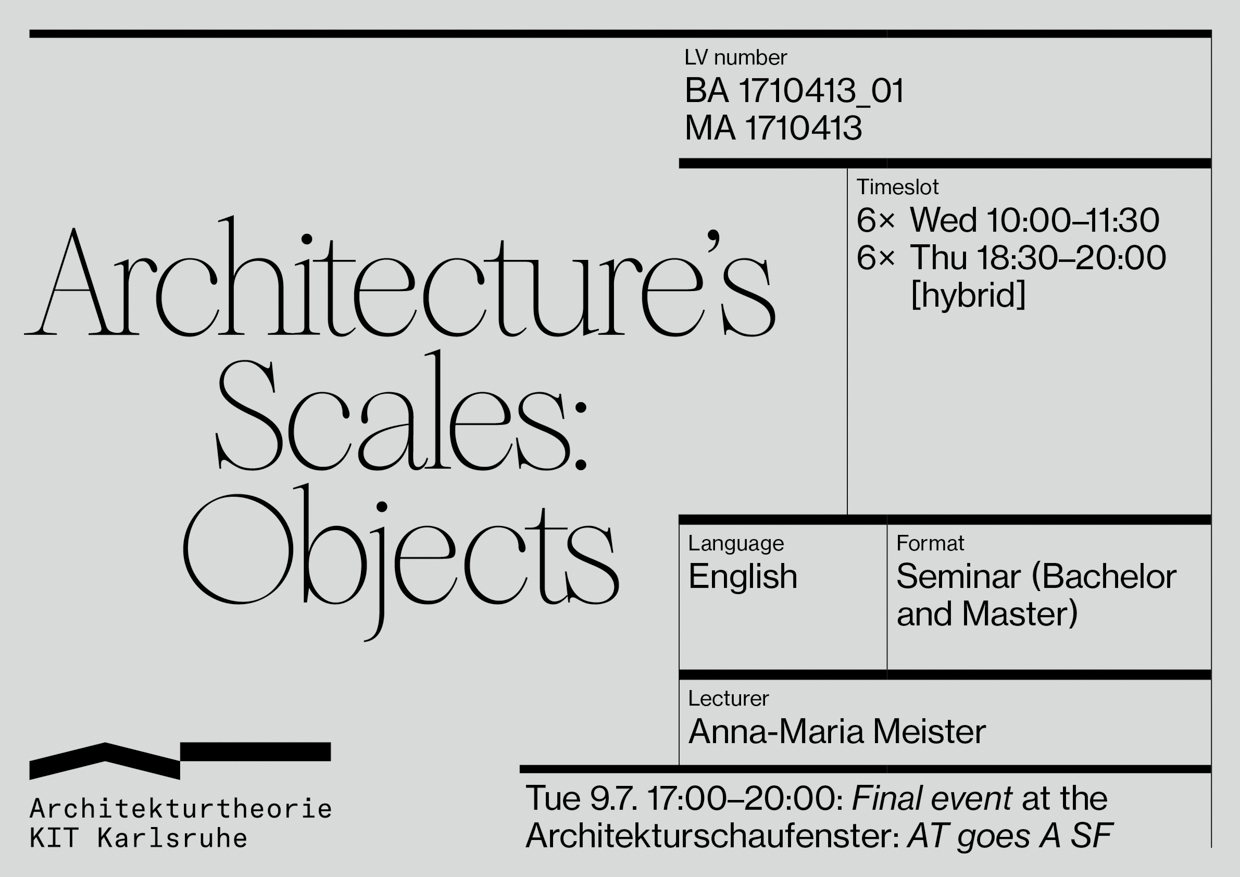
Anna-Maria Meister
Die Maßstäbe der Architektur beschränken sich nicht auf Gebäude, genausowenig wie die Wirkung von Architekturen. Vielmehr konfigurieren sich gebaute Umwelten durch architektonische Objekte verschiedener Maßstäbe: von molekularen Partikeln bis hin zur Gebäuden, Städten oder sogar abstrakten Ideen, von menschlichen Körpern, die sie erbauen und erhalten. In diesem Seminar werden wir fragen, was Architektur zum Objekt macht, indem wir wir sechs Fallstudien - von der Entwicklung normierter Gegenstände zur Frage der Objektivisierung von Architektur als "Geschenk" - untersuchen. Das Seminar wird in Zusammenarbeit mit Prof. Dr. Alla Vronskaya, Universität Kassel, und dem Kunsthistorischen Institut in Florenz - Max-Planck-Institut durchgeführt. Wir treffen uns 14-tägig (mit Online-Verbindung zur anderen Gruppe) und diskutieren einen Text, gefolgt von einer abendlichen Vorlesung (online) mit den Autor*innen.
BS
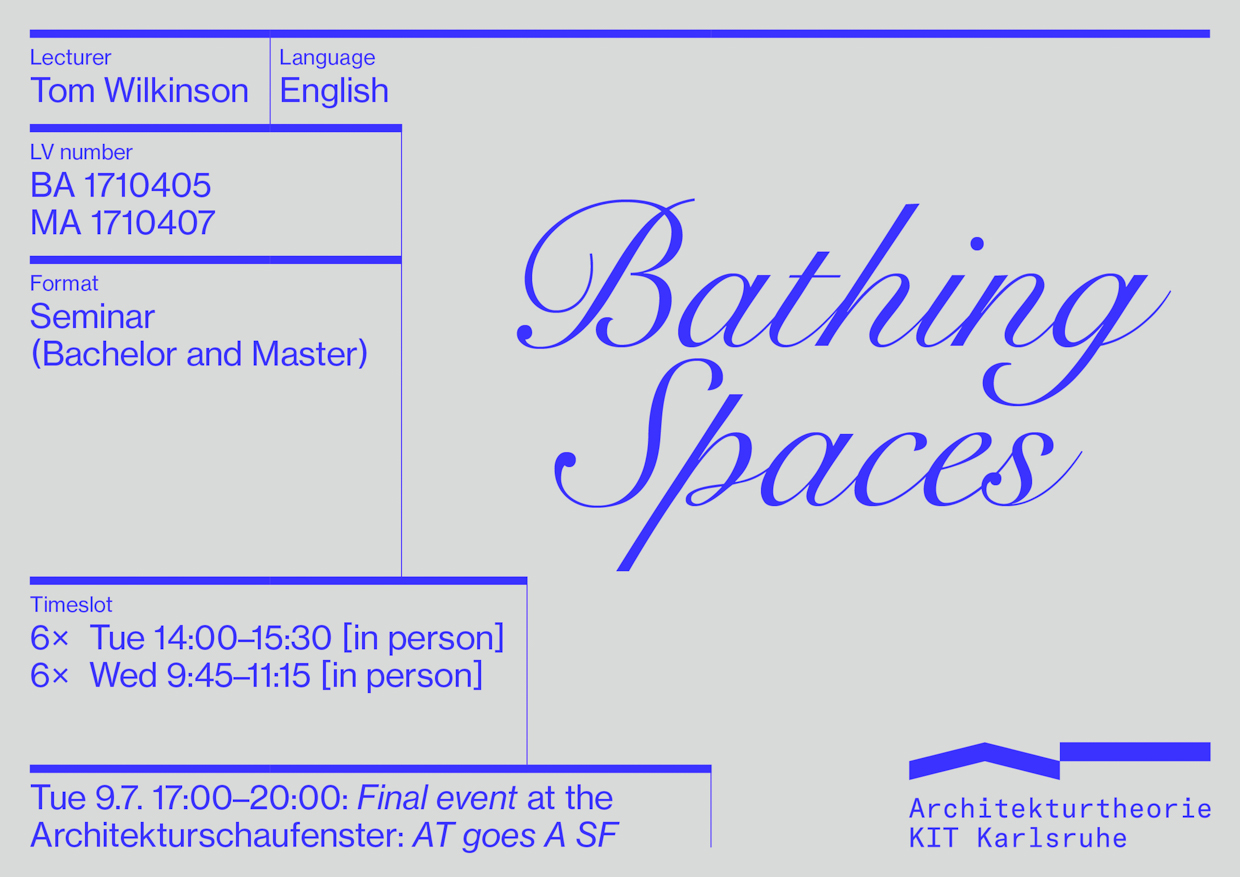
Tom Wilkinson
Menschen haben schon immer Badeeinrichtungen gebaut, sei es aus religiösen Gründen, zum Vergnügen, zur Hygiene oder für den Sport. In diesem Seminar werden wir Beispiele aus vielen Zeiten und Orten betrachten, vom präkolumbianischen Amerika bis zum modernen Tokio, von Schwulensaunen bis zu olympischen Schwimmbecken. Wir werden auch eine Vielzahl von theoretischen Texten lesen. Baderäume können demokratisch sein (daher das russische Sprichwort "In der Banja gibt es keine Epauletten"), aber sie können auch bestimmten Gruppen ausschließen. Die ungewöhnliche Nacktheit des Bades bringt soziale Spannungen an die Oberfläche und bietet gleichzeitig die Vision eines radikal gleichberechtigten Raums, der vielleicht nur eine Illusion ist.
AILA
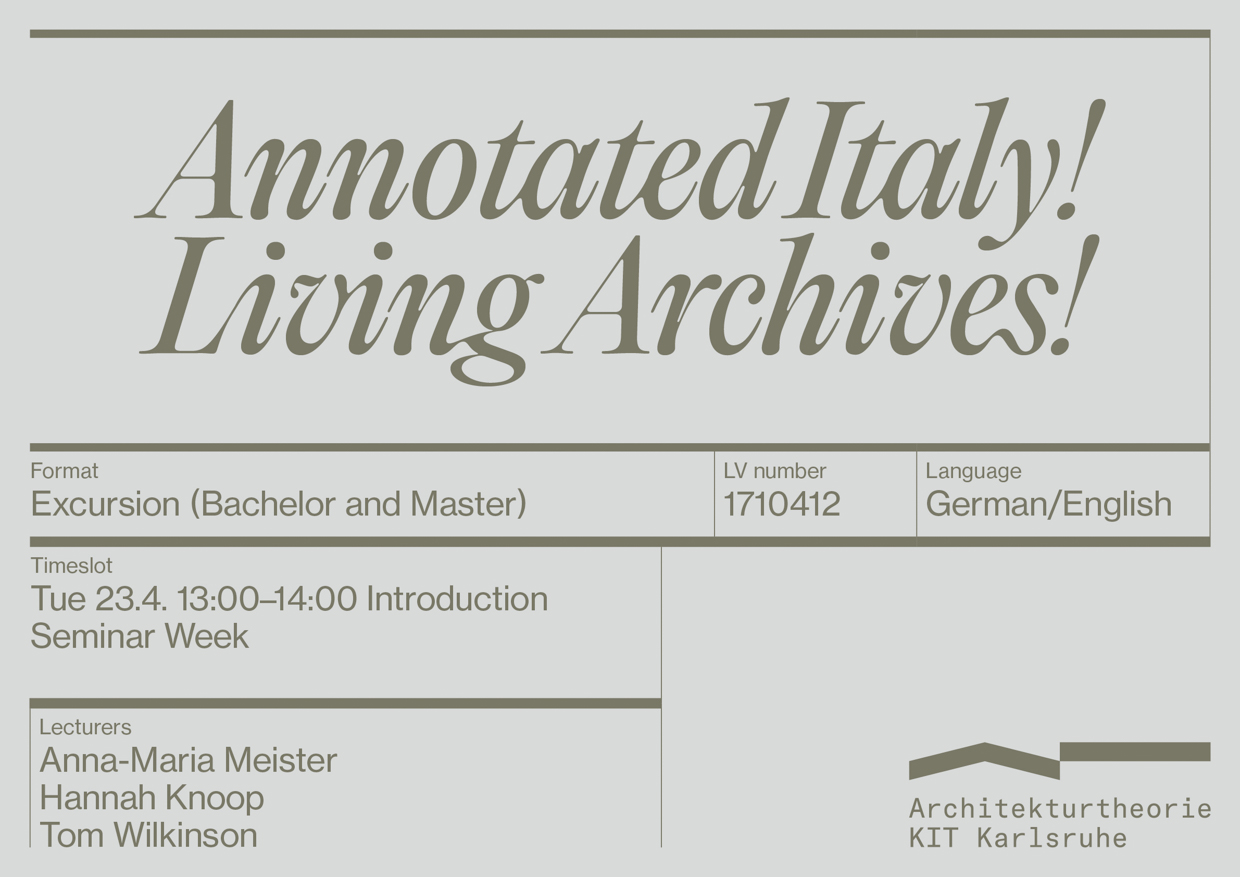
Anna-Maria Meister, Hannah Knoop, Tom Wilkinson
In einer historischen Überlagerung werden wir in der Seminarwoche eine Exkursion des KIT aus dem Jahre 2002 in Italien wiederholen und "annotieren". Mit Original-Dias, Zeitplan und gebauten Beispielen werden wir vor Ort die Alterungsprozesse, urbane und demographische Veränderungen und Vereinnahmungen seit 2002 vergleichen. Änderungen der medialen Architekturvermittlung (Dias vs. Instagram, Referat vs. TikTok) werden dabei genause veranschaulicht wie die Frage der Renaissance und Postmoderne, Antike und Archiven, die sich überlagern. Ein Workshop am Kunsthistorischen Institut in Florenz im Palazzo Grifoni wird Archivprozesse als kritische Praxis untersuchen.
AC
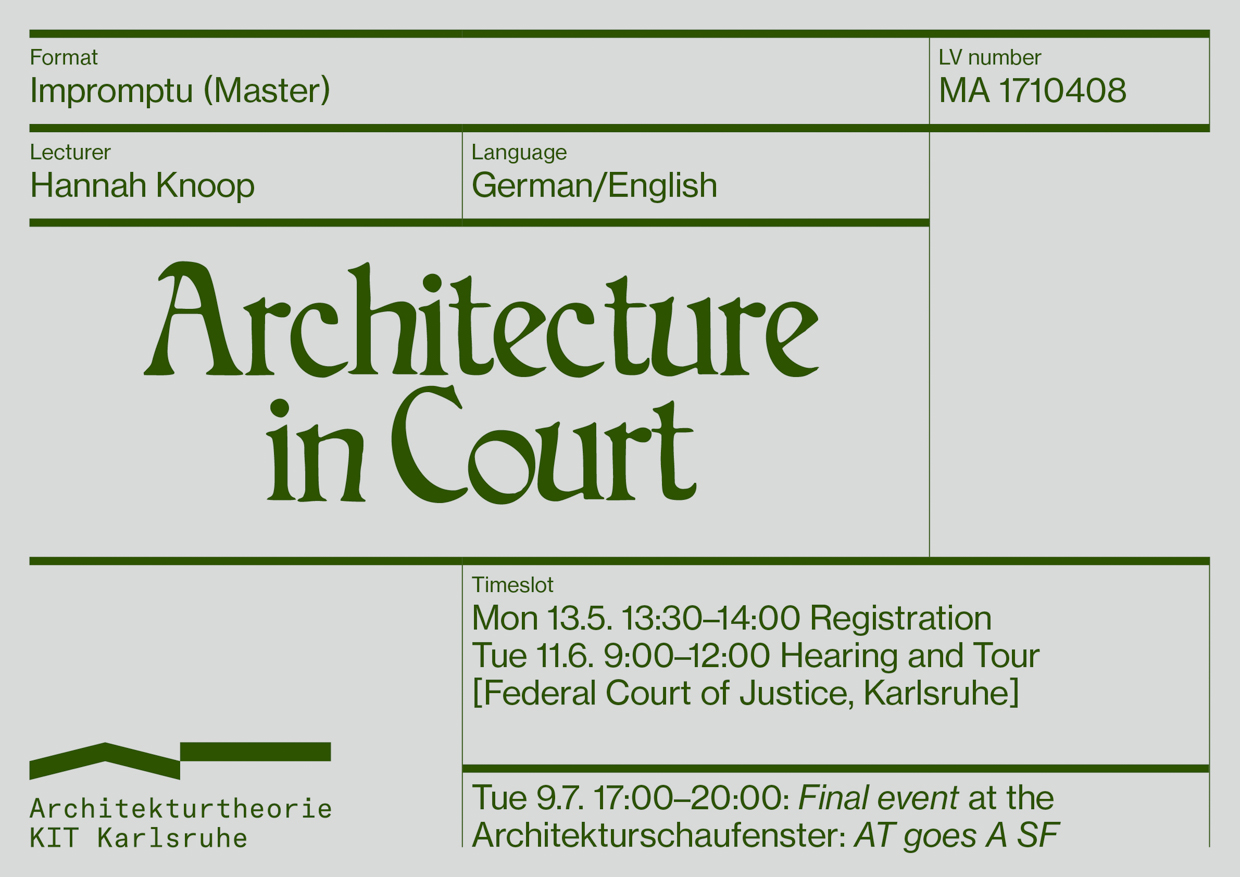
Hannah Knoop
Gehen wir vor Gericht! Fassaden und Versammlungshallen sind bekannte architektonische Symbole für Macht und Politik. Doch einzelne Artefakte werden oft übersehen. Wir wollen uns den Karlsruher Bundesgerichtshof genauer anschauen, seine architektonischen Artefakte mit Blick auf ihre Wirkmacht analysieren und weiterdenken. Dafür nehmen wir an einer Verhandlung teil und lassen uns durch die Gebäude führen. Basierend auf euren Beobachtungen entwerft ihr dann Visionen, Utopien oder Dystopien für ein Artefakt eurer Wahl. Erzählt seine Geschichten, frei nach „the medium is the message“. Abgabeleistung ist eine Collage, 2er-Gruppen sind möglich.
Offen für alle Masterstudierende, obligatorisch für „Architecture of Decision-Making“– Teilnehmer*innen.
Patentnichtigkeit und Artefakte
CTA
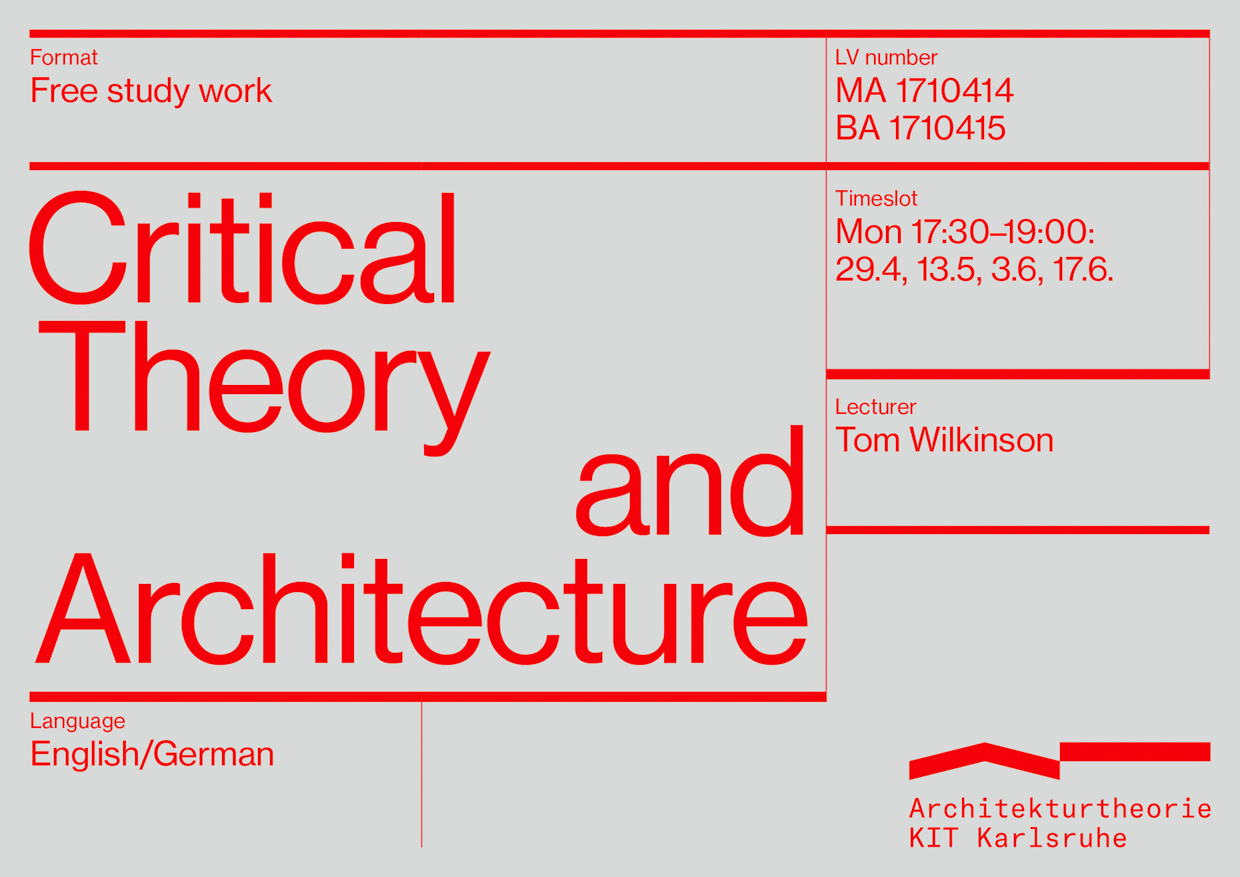
Tom Wilkinson
Die Kritische Theorie ist eine Denktradition, die vor 100 Jahren in Deutschland begann: Diese Vortragsreihe argumentiert, dass sie auch heute noch für das Nachdenken über Architektur nützlich ist. Beginnend mit Siegfried Kracauer, einem ausgebildeten Architekten und häufigen Autor zu diesem Thema, und Walter Benjamin, der wie besessen an den Pariser Arkaden arbeitete, werden wir zu ihren Nachkriegsnachkommen wie Jürgen Habermas, Manfredo Tafuri und Angela Davis übergehen und ihre Kritik, ihre Streitigkeiten und ihre Grenzen untersuchen.
CBRA
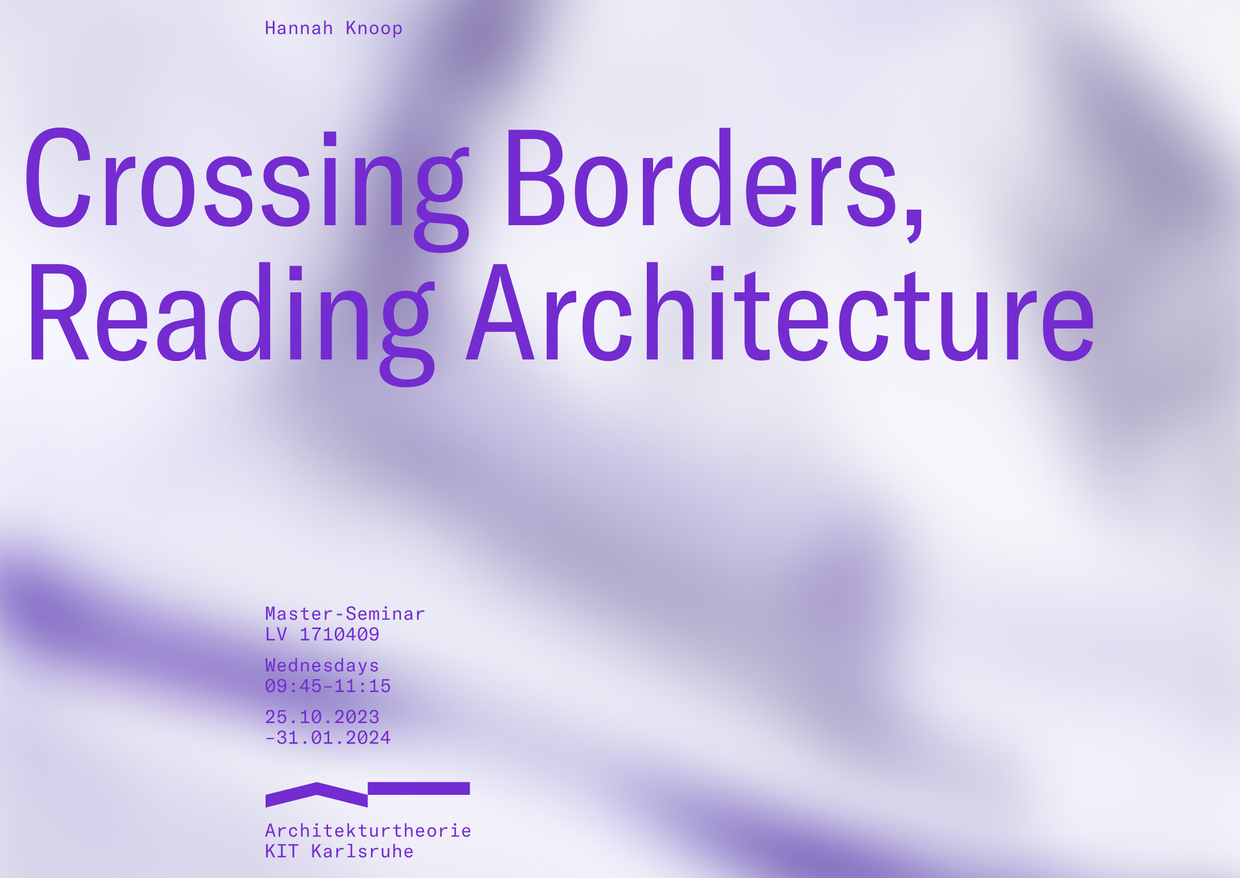
Hannah Knoop
Grenzen trennen nicht nur Reiche, Nationalstaaten und Territorien; sie demonstrieren auf drastische Weise globale Ungleichheit - vom Traum des Kosmopolitismus für die einen bis zur Realität der "Sortiermaschine" und Festung für die anderen.
Wie genau sehen historische und aktuelle Grenzarchitekturen, auch jenseits von Mauern, Zäunen und Überwachungstürmen, aus? Wer hat sie entworfen? Welche Architekturen prägen Grenzen? Durch "deep reading" ausgewählter Texte aus der Architekturtheorie, der Soziologie oder postkolonialer Studien sollen diese und andere Fragen aufgegriffen und diskutiert werden.
Das Seminar ist als Leseseminar konzipiert und kann im Sommersemester in Zusammenarbeit mit der EPFL Lausanne und/oder einem Forschungsprojekt erweitert werden.
MWS
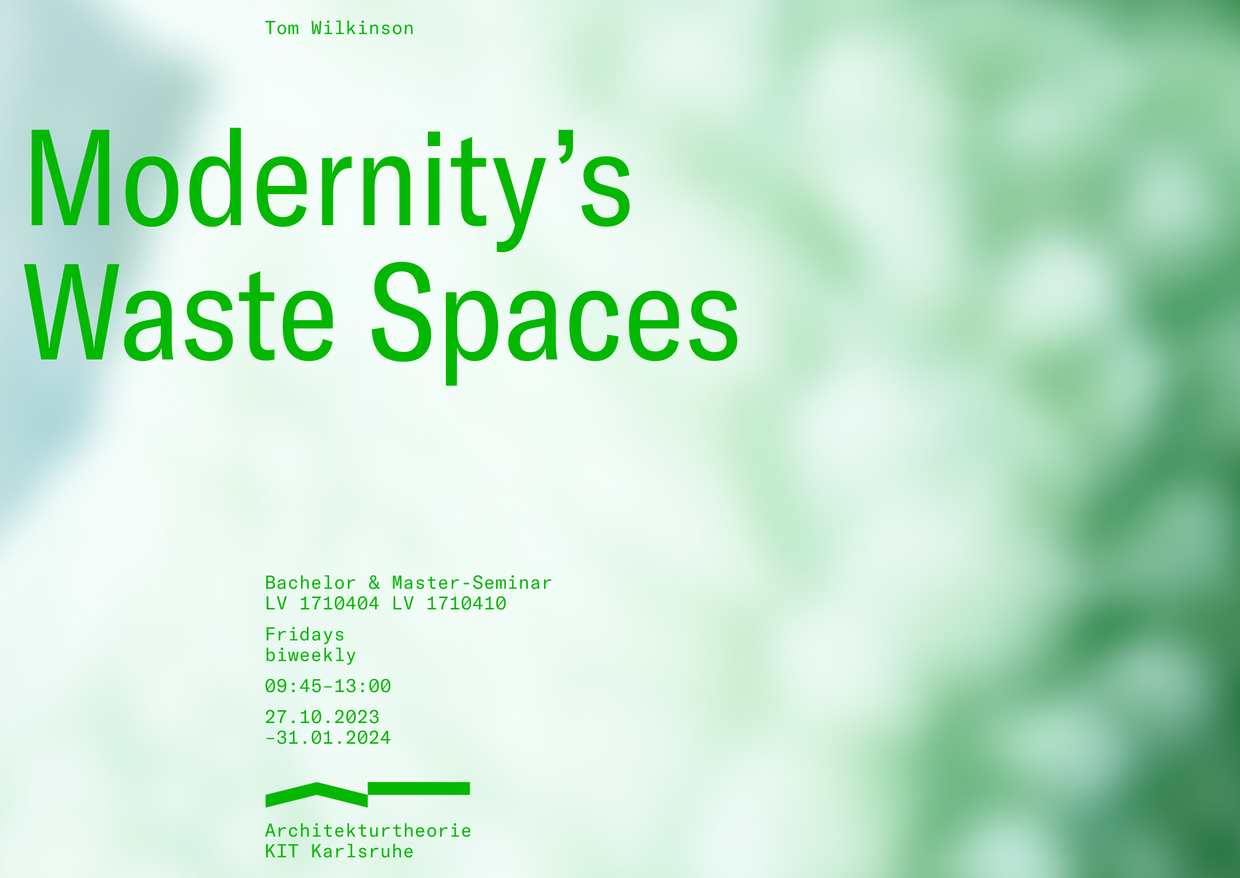
Tom Wilkinson
Im Hinblick auf das Problem des Abfalls wird sich dieses Seminar auf die Resträume der Moderne konzentrieren: Halden, Abwasserkanäle, Lager, verlassene Einkaufszentren, etc.
Sie sind Nebenprodukte der Modernisierung und Lagerstätten des Mülls der Moderne, einschließlich des "menschlichen Mülls", um Zygmunt Baumans (problematische) Formulierung zu verwenden.
Ausgehend von der Hypothese, dass der modernistische Raum und die Resträume der Moderne sich gegenseitig produzieren, werden wir Quellen und Beispiele aus der ganzen Welt analysieren. Da es sich bei der Modernisierung um einen dialektischen Prozess handelt, werden wir uns auch mit den Versuchen der Designer befassen, Resträume wiederzuverwenden.
RP
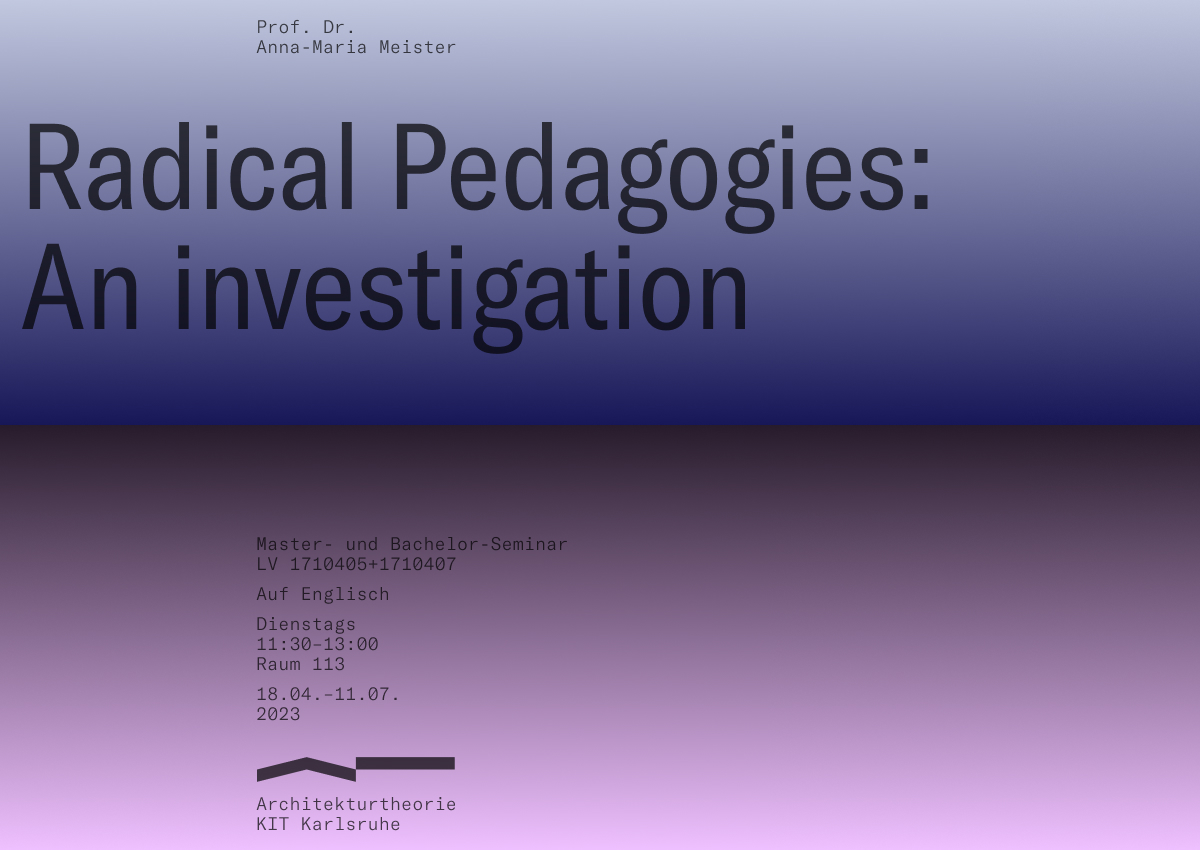
Anna-Maria Meister
In diesem Seminar werden wir die Transformation der Architekturausbildung nach dem Zweiten Weltkrieg und ihre Auswirkungen auf heutige Fragen anhand des kürzlich erschienenen Buches "Radical Pedagogies" (MIT Press 2022) diskutieren. Die historischen Fallstudien und ihre Bemühungen, den Status quo der Architektur zu überwinden, dienen als Testfeld für pädagogische Strategien, die wir heute anwenden könnten. Die historischen radikalen Experimente zielten darauf ab, die disziplinären Grundlagen und konventionellen Annahmen über das Wesen der Architektur in Frage zu stellen, sie forderten modernistische und koloniale Normen heraus, und formulierten neue Rollen für Architekt*innen oder neue partizipatorische Formen der Praxis. Obwohl viele der experimentellen Programme nach kurzer Lebensdauer beendet oder absorbiert wurden, prägten sie dennoch den architektonischen Diskurs und die architektonische Praxis nachhaltig. Betrachtet man ihre Auflösung und ihr Nachleben zusammen mit ihrer Entstehung, so werfen diese Projekte aus dem letzten Jahrhundert provokante Fragen über die Rolle der Architektur im neuen Jahrhundert auf. Die Sprache der Lektüre und der Diskussion ist Englisch.
AS
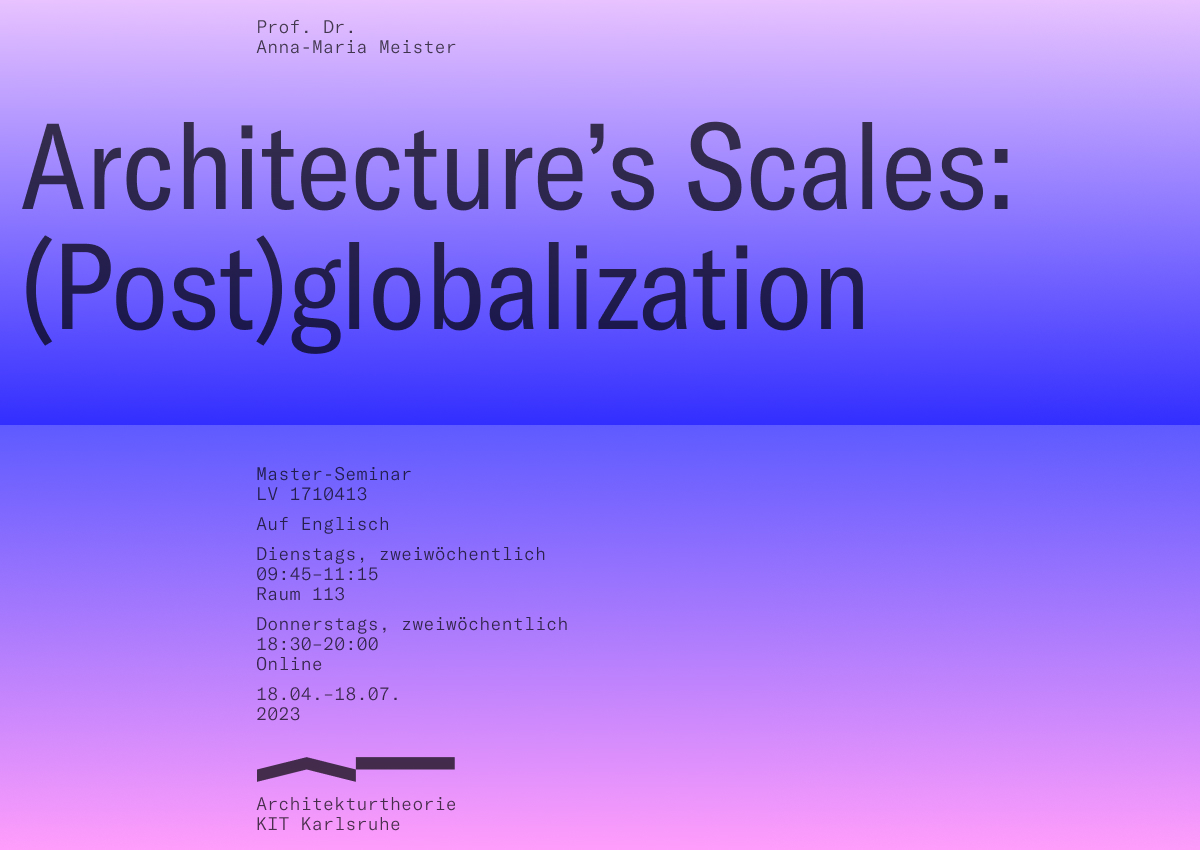
Anna-Maria Meister
Die Maßstäbe der Architektur beschränken sich nicht auf Gebäude, genausowenig wie die Wirkung von Architekturen. Vielmehr reichen die Auswirkungen und Effekte gebauter Umwelten von molekularen Partikeln bis hin zur globalen Logistik des Ressourcenabbaus, von menschlichen Körpern, die sie erbauen und erhalten, bis hin zu regionalen Effekten demographischer Verschiebungen oder kultureller Aneignungen. In diesem Seminar werden wir uns diesen Fragen nähern, indem wir die verschiedenen Skalen moderner und zeitgenössischer Gesellschaften betrachten. Wir werden sowohl die Entstehung als auch die gegenwärtige Krise der etablierten Strukturen der Globalisierung erörtern, die durch wirtschaftliche Interessen gefestigt und durch Kriege und Massenvertreibungen erschüttert wurden. Zu diesem Zweck werden wir sechs Fallstudien verschiedener Maßstäbe - von der Community über die Kolonie bis hin zu transnationalen Netzwerken - untersuchen.
Das Seminar wird in Zusammenarbeit mit Prof. Dr. Alla Vronskaya, Lehrstuhl für Architekturtheorie und -geschichte an der Universität Kassel, durchgeführt. Wir treffen uns zweiwöchentlich persönlich (mit Online-Verbindung zur anderen Gruppe) und diskutieren einen Text eines führenden zeitgenössischen Gelehrten oder Architekturtheoretikers, gefolgt von einer abendlichen Vorlesung und Diskussionsrunde (online) mit den Autor*innen der jeweiligen Texte. Die Sprache der Lektüre und der Diskussion ist Englisch.
AE
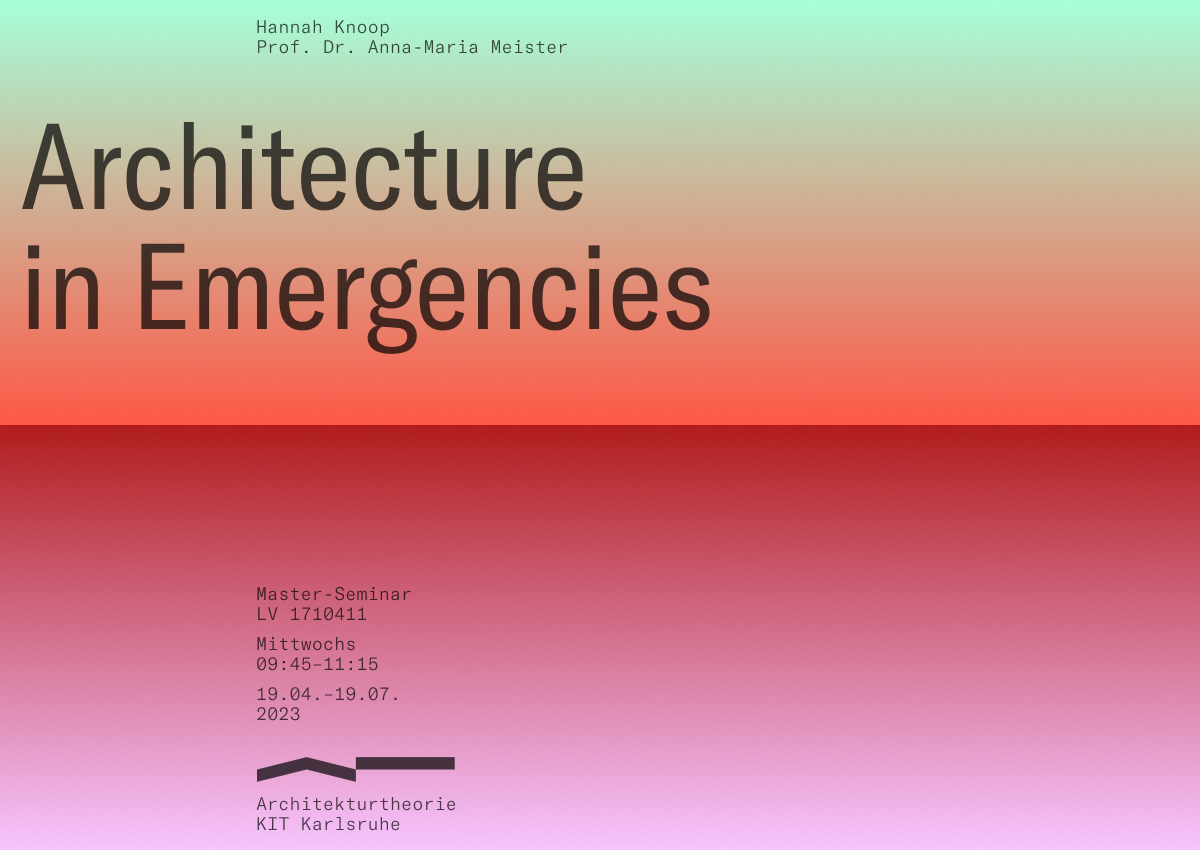
Hannah Knoop
Notsituationen sind allgegenwärtig: sie haben globale Auswirkungen und werden meist durch globale ökologische, ökonomische und soziale Faktoren ausgelöst.
Die erste Maßnahme in einem akuten Notfall ist ein Dach. Ihm folgen Wände und weitere bauliche Elemente – so gibt es die „Bibel der Camp-Planung“, das Handbook for Emergencies des UNHCRs vor. Auch im größeren Maßstab spielen Architektur und Stadtplanung in der Krise eine entscheidende Rolle. Doch wie werden Notsituationen definiert? Wer ist planerisch und gestalterisch beteiligt? Welche Architekt*innen haben Standards für Notsituationen entworfen?
Die Veranstaltung ist als Lektüre- und Rechercheseminar zu Projekten konzipiert und bietet ein Forum für intensiven Austausch untereinander.
SDLLS
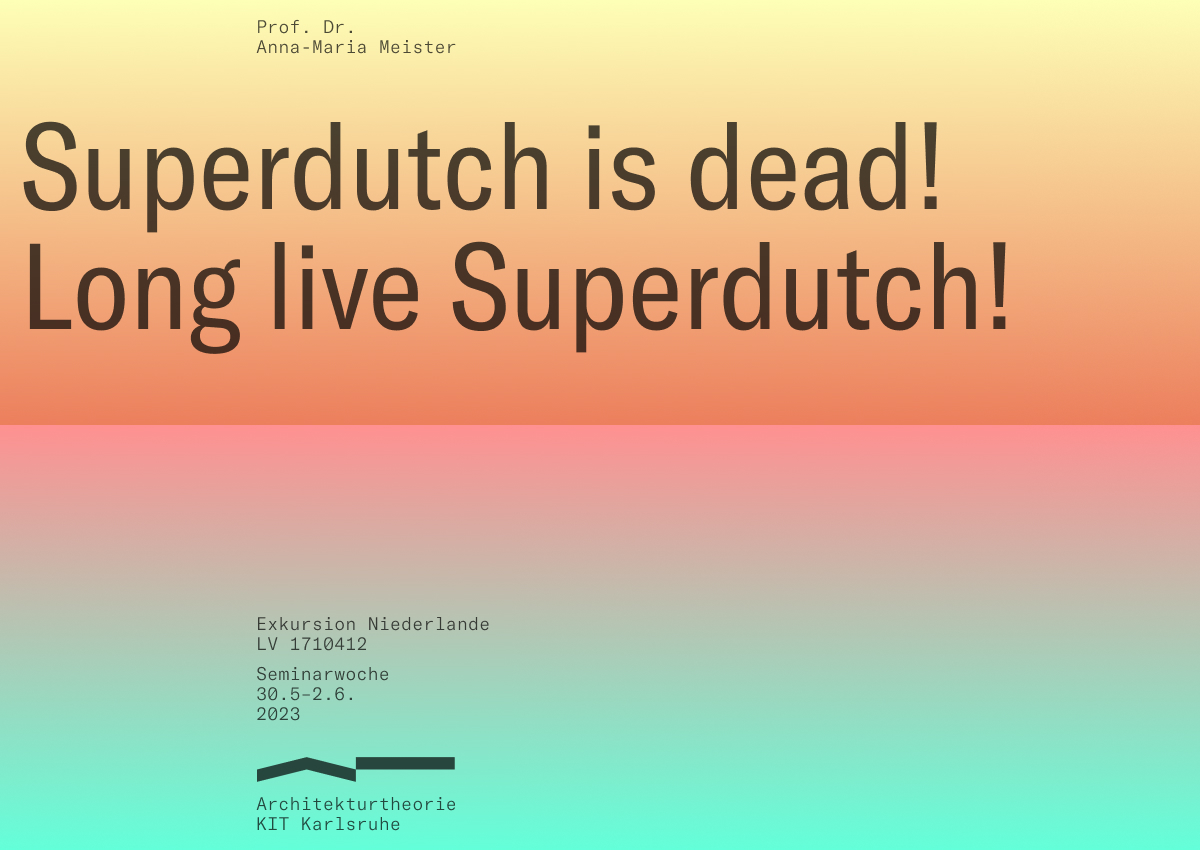
Anna-Maria Meister
In einer historischen Überlagerung werden wir in der Seminarwoche eine Exkursion des KIT aus dem Jahre 1999 in die Niederlande wiederholen. Mit Original-Dias, Zeitplan und gebauten Beispielen werden wir vor Ort die Alterungsprozesse, urbane und demographische Veränderungen und Vereinnahmungen mit 1999 vergleichen. Änderungen der medialen Architekturvermittlung (Dias vs. Instagram, Referat vs. TikTok) werden dabei genause veranschaulicht wie die Folgen der Superdutch Welle der 1990er, die in Masterplänen und Ästhetik bis heute nachwirkt.
SR
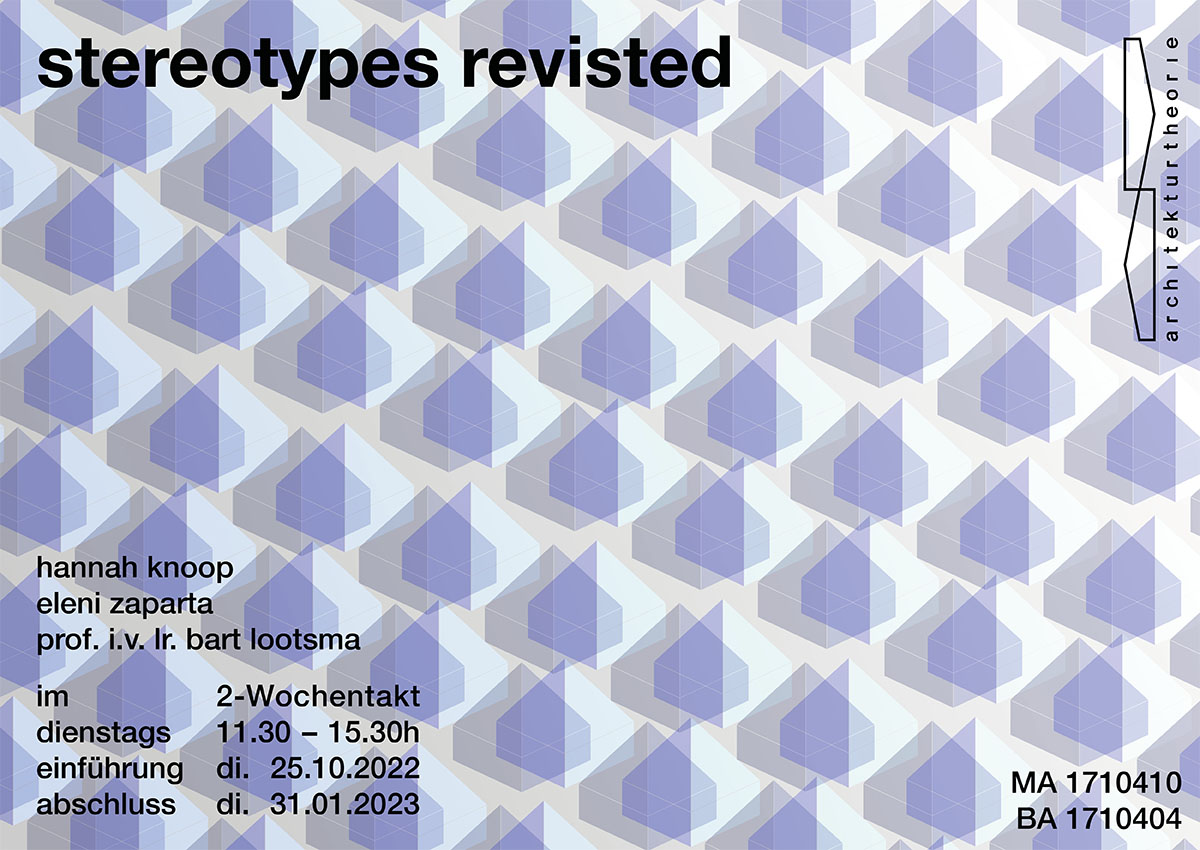
Hannah Knoop, Eleni Zaparta, Bart Lootsma
Stereotypen, Muster, Normen und Standards prägen Umwelt und Architektur. Ob durch Vorschriften und Gesetze, als Entwurfswerkzeug oder aus gesellschaftlichen Diskursen übernommen, geben sie Ordnung und Struktur. Doch wie entstehen Stereotypen? Wer prägt sie, auf welchen entwerferischen, gesellschaftlichen und gesetzlichen Grundlagen bauen sie auf? Architektur kann technische und gesellschaftliche Innovationen widerspiegeln, aber auch längst überholtes manifestieren. Beides gilt es aufzudecken und zu hinterfragen.
Die Veranstaltung ist als Lektüre- und Rechercheseminar konzipiert. Ziel ist es die Dimensionen von Stereotypen kritisch zu ergründen und anhand von Projekten auch das eigene Entwerfen zu beobachten.
RAEA
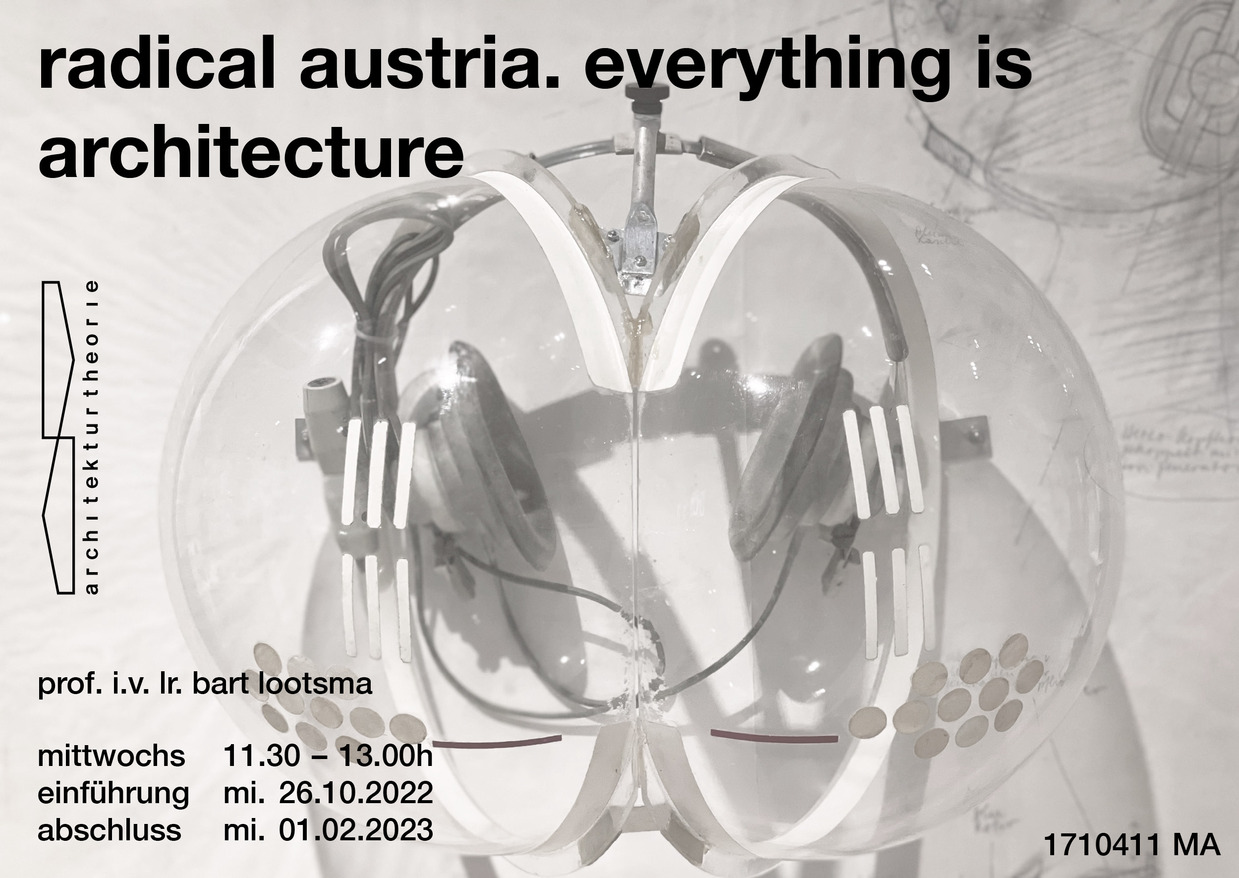
Bart Lootsma
ACZ
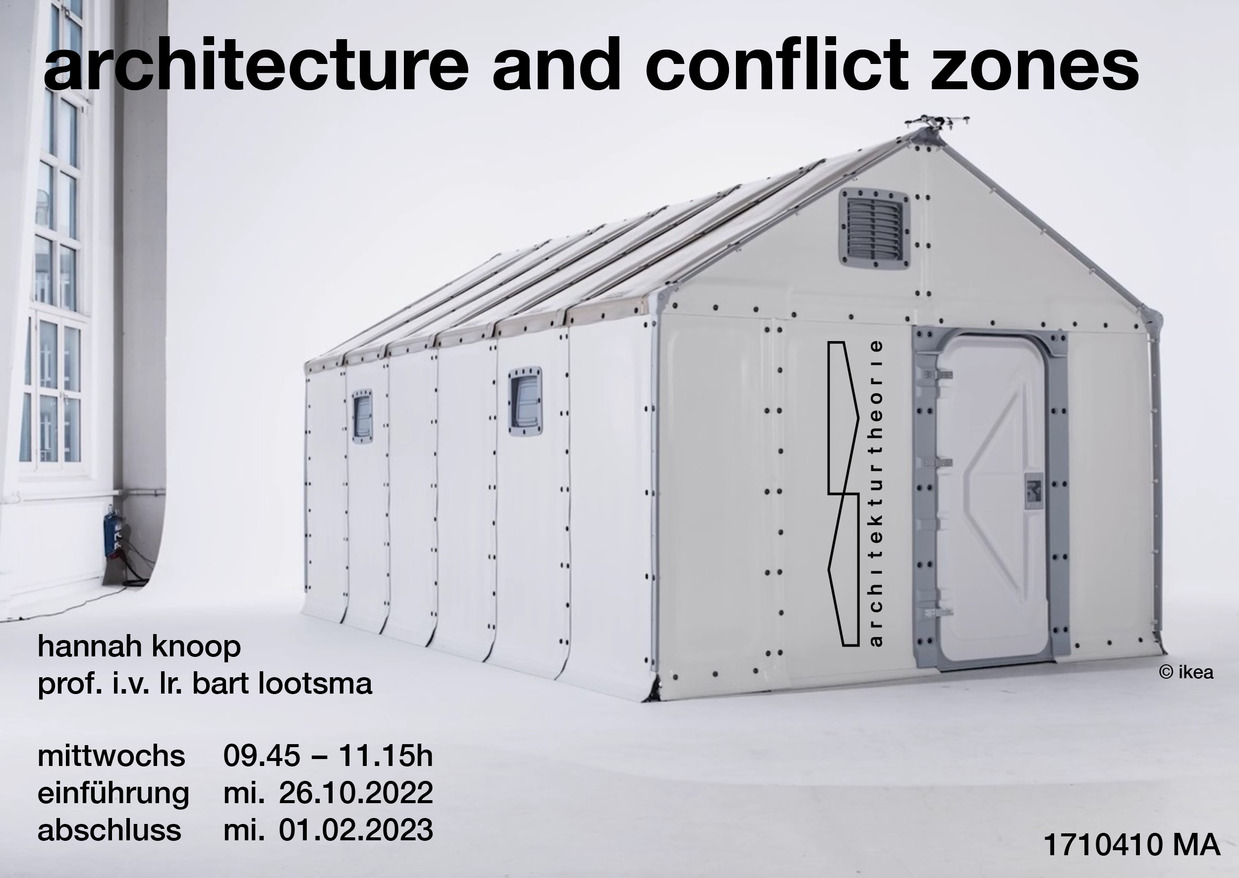
Hannah Knoop
Architektur ist ein geostrategischer und politisch umkämpfter Raum. Repräsentative Bauten, Infrastrukturprojekte oder Wohn– und Stadtraum sind sowohl Bühne als auch Gegenstand unterschiedlichster Aushandlungsprozesse. Die aktuellen Debatten zu Vertreibung, Krieg und Klimakrise zeugen davon. Welche Rolle spielt die Disziplin für politische Ziele wie Verteidigung, Territorium und Besetzung sowie für räumliche Gerechtigkeit und Fragen der Staatsbürgerschaft? Wie lässt sich Architektur nicht nur als Spielball geopolitischer Strategien, sondern als aktiver Akteur auch im Kontext der Menschenrechte begreifen?
Die Veranstaltung ist als Lektüre- und Rechercheseminar zu Projekten konzipiert und bietet ein Forum für intensiven Austausch untereinander.
WAS
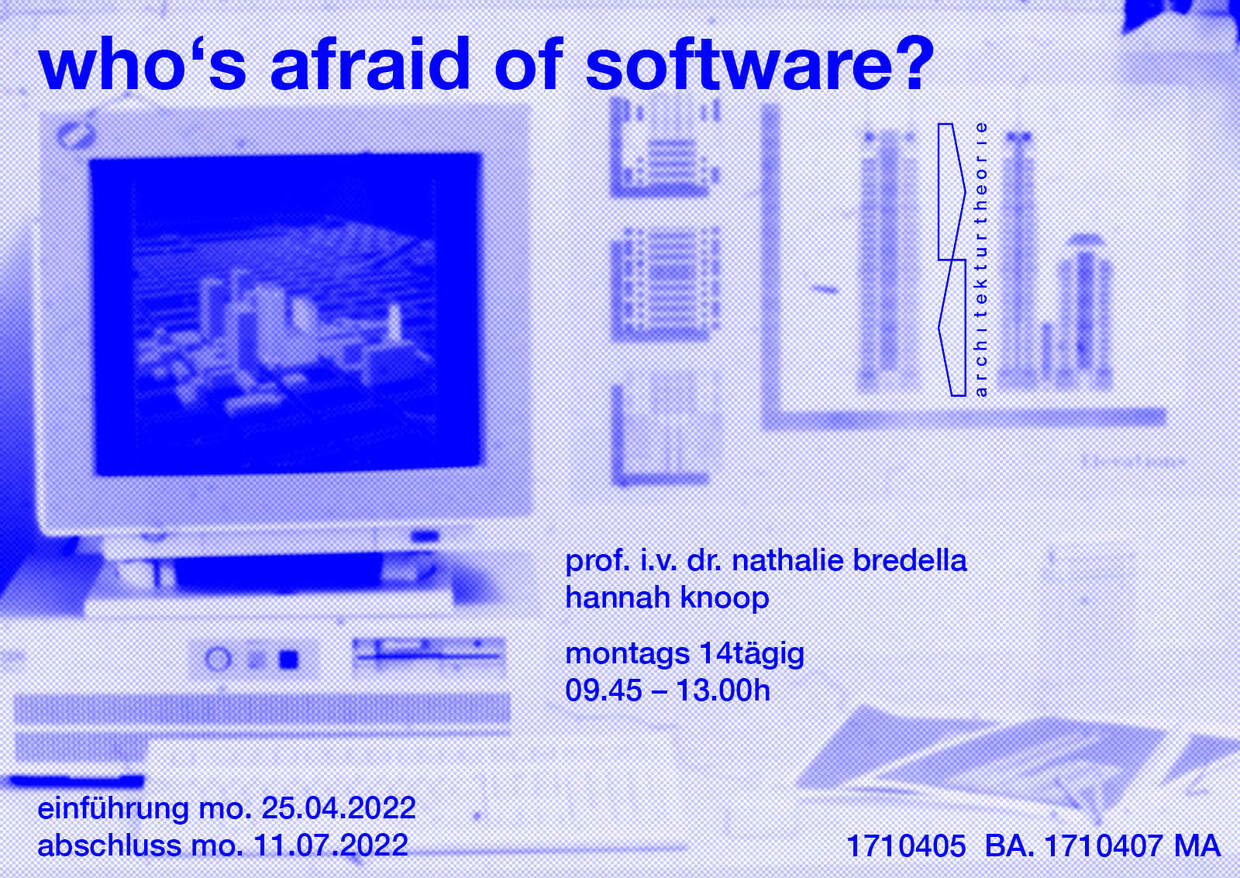
Hannah Knoop
Wird Architektur noch ‚von Menschen für Menschen‘ entworfen, oder befinden wir uns längst im Zeitalter eines posthumanen Designs? Digitale Entwurfswerkzeuge, Algorithmen sowie die Erhebung und Interpretation von Daten prägen und bestimmen den Entwurfsprozess zunehmend: von den ersten Skizzen bis zur Realisierung und Objektüberwachung. Der Faktor Mensch fließt dabei als Datensatz ein. Das Seminar thematisiert diese Entwicklung und die damit eng verknüpfte Sorge um Einschränkung der Kreativität und eine diffuse Angst vor Verlust von Autonomie.
Die Veranstaltung ist als Lektüre– und Rechercheseminar konzipiert. Ziel ist es, anhand von Beispielen einen kritischen Blick auf digitale Entwurfswerkzeuge und ihre Kulturgeschichte zu werfen.
MDT
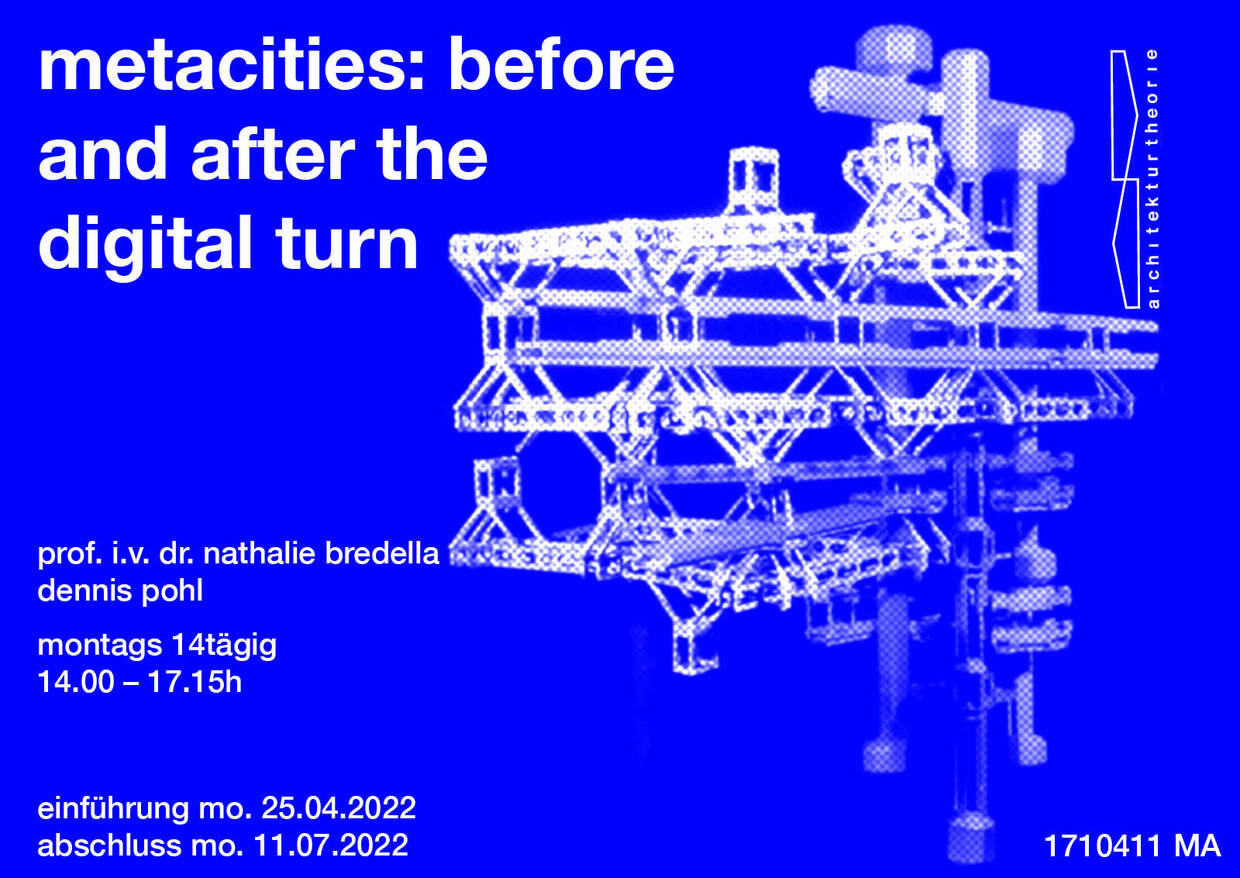
Dennis Pohl
Die heutigen Smart Cities realisieren die Metastädte der 60er und 70er Jahre. Nutzerdaten, Bewegungsströme und Anpassungsfähigkeit sind nicht nur die Ansprüche neuer Smart City Entwürfe sondern bereits elementarer Bestandteil der früheren Metastadt-Planung. In den 60er und 70er Jahren wird das Soziale zu Wert und Ware für gebaute Umwelt. Welche Medien, und Methoden wirken aus dieser Epoche auf die Architektur heute? Was für Ursprünge hat die Ökonomisierung des Sozialen in der kybernetischen Stadtplanung?
Die Veranstaltung ist als Lektüre– und Rechercheseminar konzipiert. Ziel ist es, einen kritischen Blick auf die Geschichte der Digitalisierung von Smart Cities zu werfen, und die Effekte auf heutige Stadtplanung zu hinterfragen.
GP
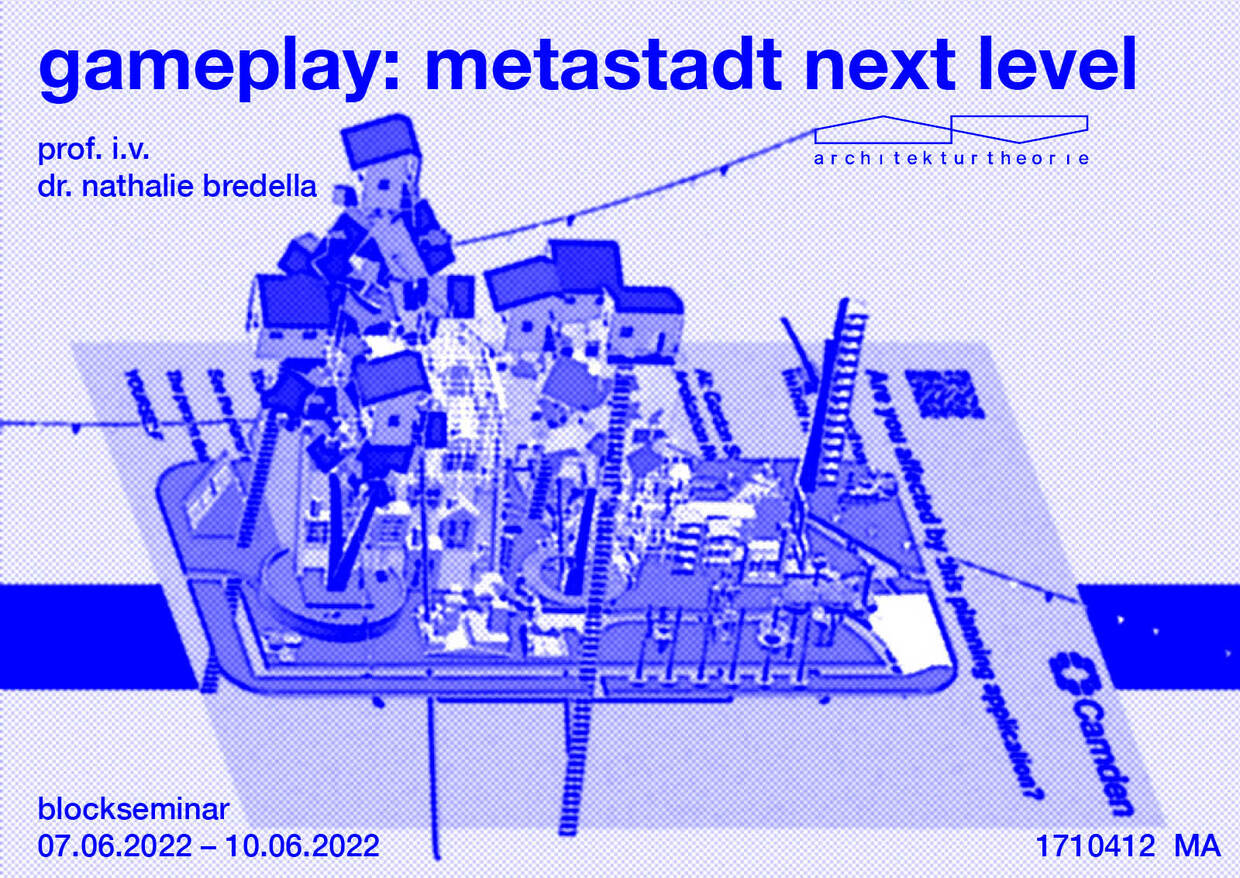
Nathalie Bredella
Urban Games machen alternative Zukünfte vorstellbar, während experimentelle Entwürfe (Metastadt, R. Dietrich) Spielprogramme und spielerische Aushandlungsprozesse im Rahmen der Planung einsetzen. Das Seminar geht dem Wechselspiel von Spiel und Planung nach und beschäftigt sich mit Vorstellungen von Architektur und Stadt, die in Spielsysteme eingeschrieben und durch das Spielen ‚enacted’ werden. Gemeinsam werden wir Spielmechaniken erkunden und interaktive Elektronikinstallationen entwickeln, die das Feedback zwischen Planungsstrategien und Spiel erproben.
HS
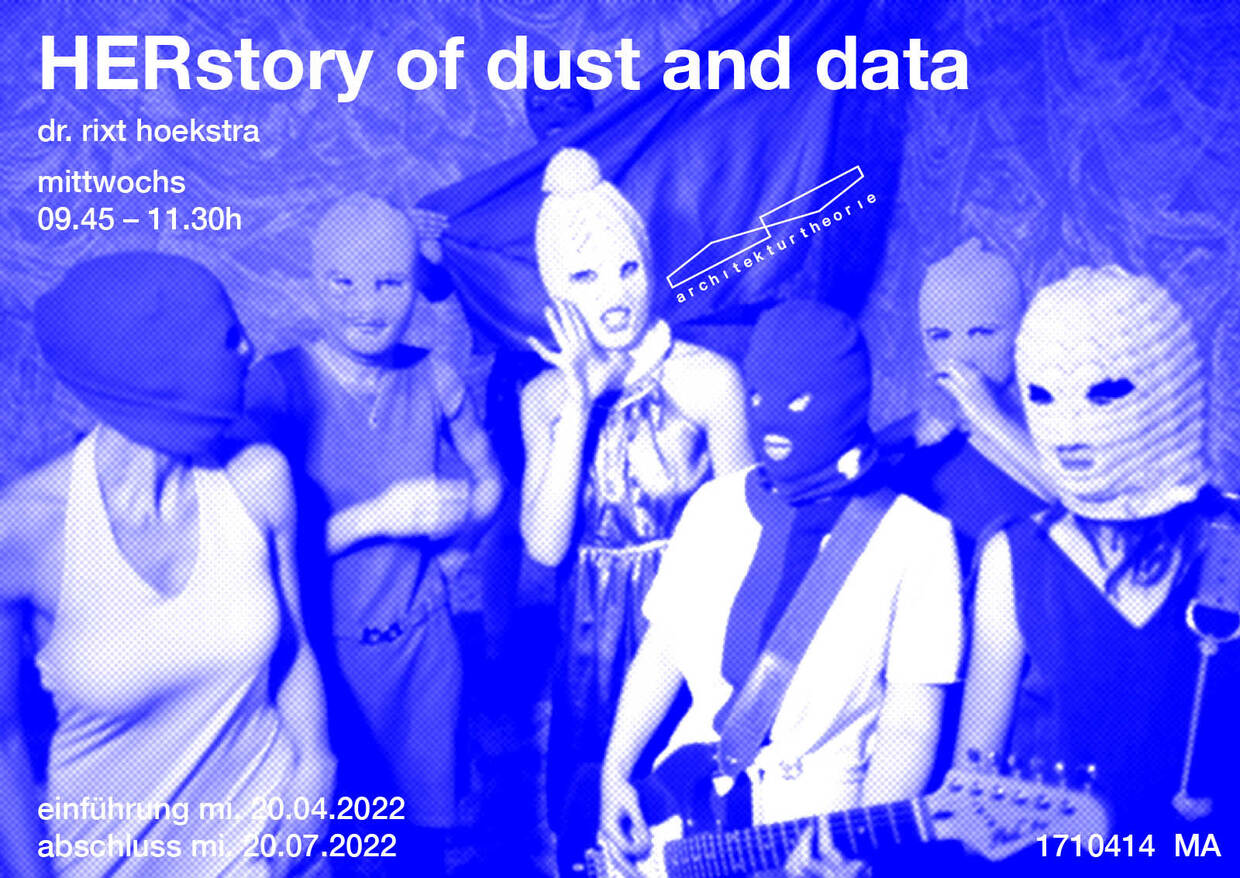
Rixt Hoekstra
Archive sind weder neutrale noch stabile Institutionen, sondern politische Instanzen. Die Architekturgeschichte ist wiederum von den in Archiven zugänglichen Quellen abhängig. Die Marginalisierung von Architektinnen in der Architekturgeschichte hängt folglich damit zusammen, dass ihre Entwürfe und Texte nicht systematisch gesammelt wurden. Dies ist der Ausgangspunkt für unser Forschungsseminar. Wir werden Architekturarchive besuchen und fragen, nach welchen Kriterien Daten über Architektinnen und ihre Werke archiviert werden und Perspektiven für Archivierungsstrategien diskutieren. Wir begreifen die Archivarbeit als eine mögliche Form des Aktivismus im Architekturdiskurs.
AD
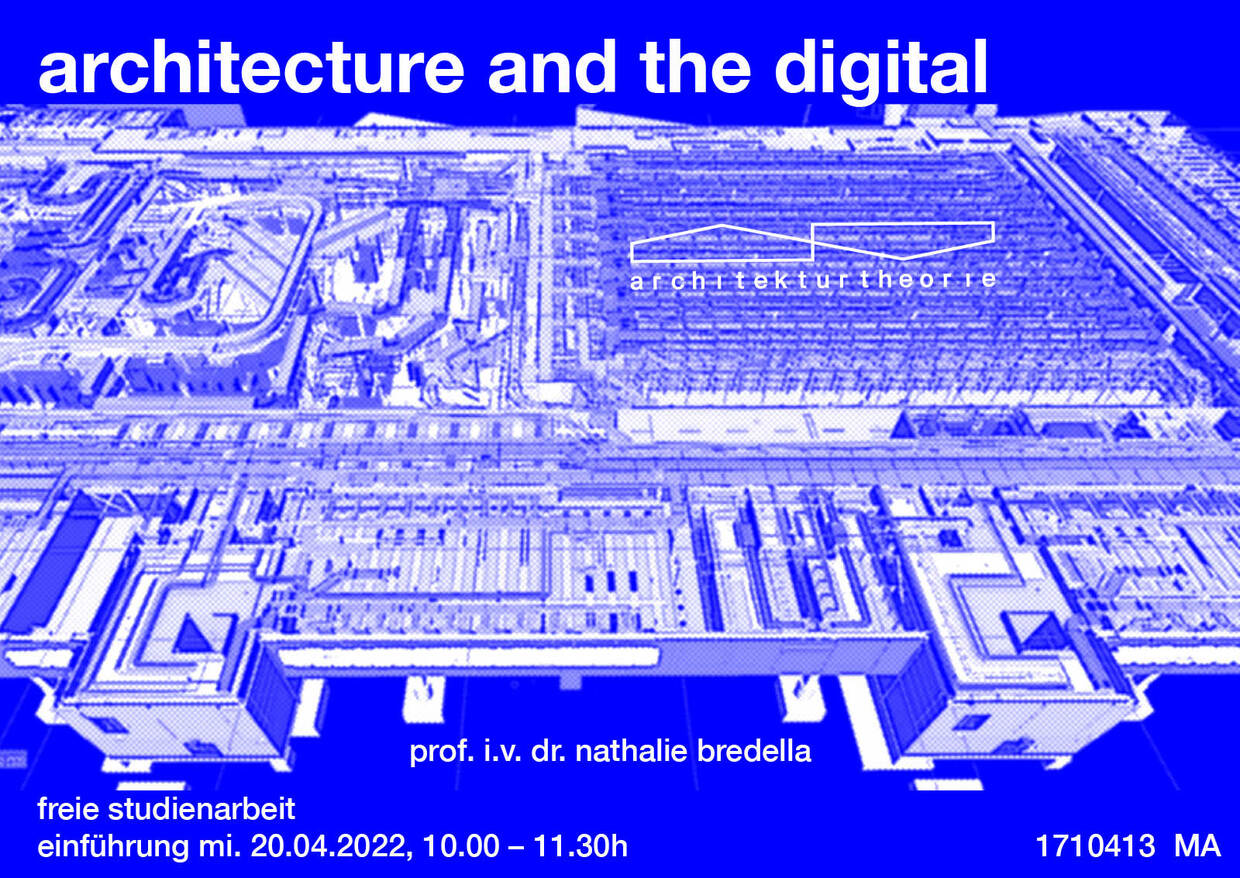
Nathalie Bredella
Die Formulierung von Forschungsfragen sowie methodische Ansätze stehen im Fokus des Forschungsseminars, das sich mit ausgewählten Themen der Digitalisierung in der Architektur, mit Visualisierungsprozessen und der Wirkmacht von Werkzeugen im Entwurf befasst.
IPA
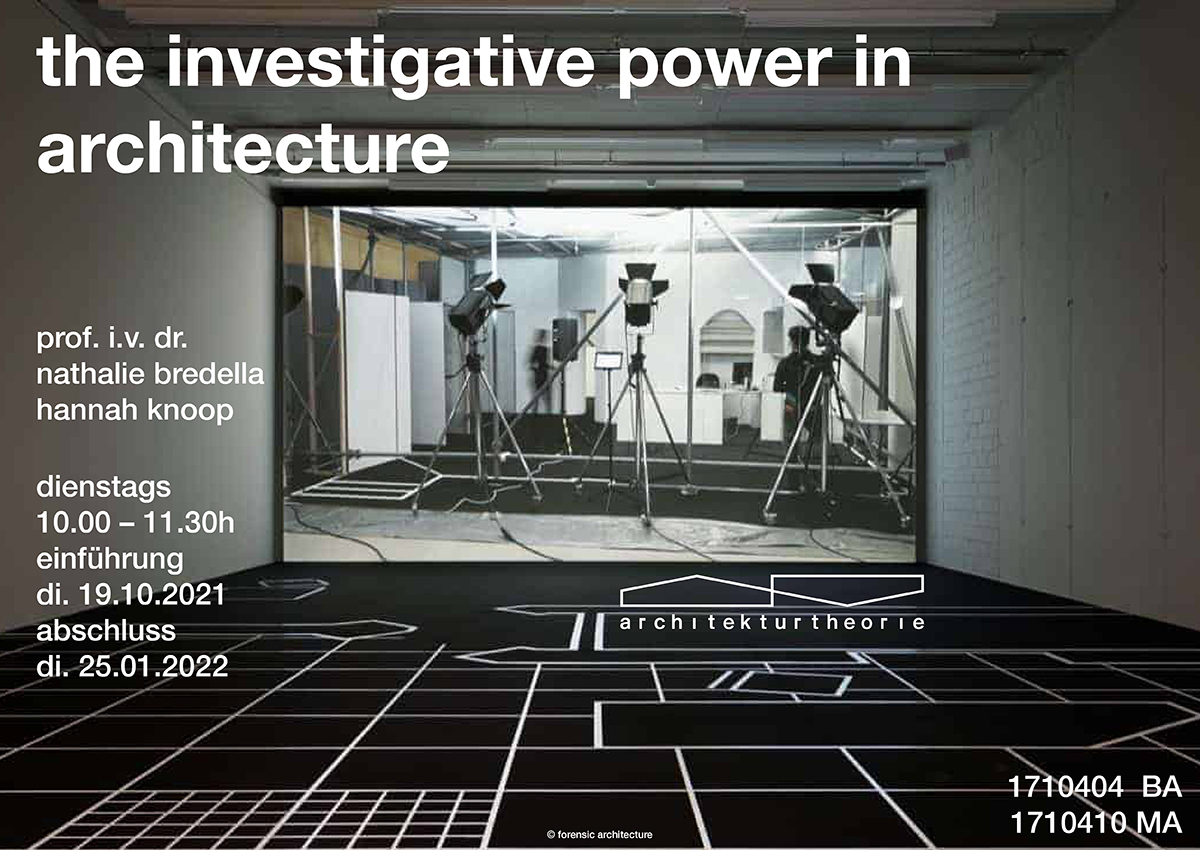
Hannah Knoop
Architektur ist eine materielle Zeugin. Ihre Befragung zeigt gesellschaftliche Strukturen auf und liefert entscheidendes Beweismaterial für Konflikte und Tathergänge. Investigative Untersuchungen von gebauten Objekten kombinieren räumliche Strategien aus der Architektur mit forensischen und journalistischen Methoden. Sie dienen dem Aufdecken und Aufklären von Machtverhältnissen und Machtstrukturen, wie Arbeiten von Forensic Architecture, Alisson Killing und anderen zeigen.
Die Veranstaltung ist als Lektüre- und Rechercheseminar konzipiert. Ziel des Seminars ist es, sich mit den neuen Formen kollaborativer Wahrheitsfindung und Architektur als investigativer Praxis auseinanderzusetzen, sie kritisch zu hinterfragen und historisch einzuordnen.
AOS
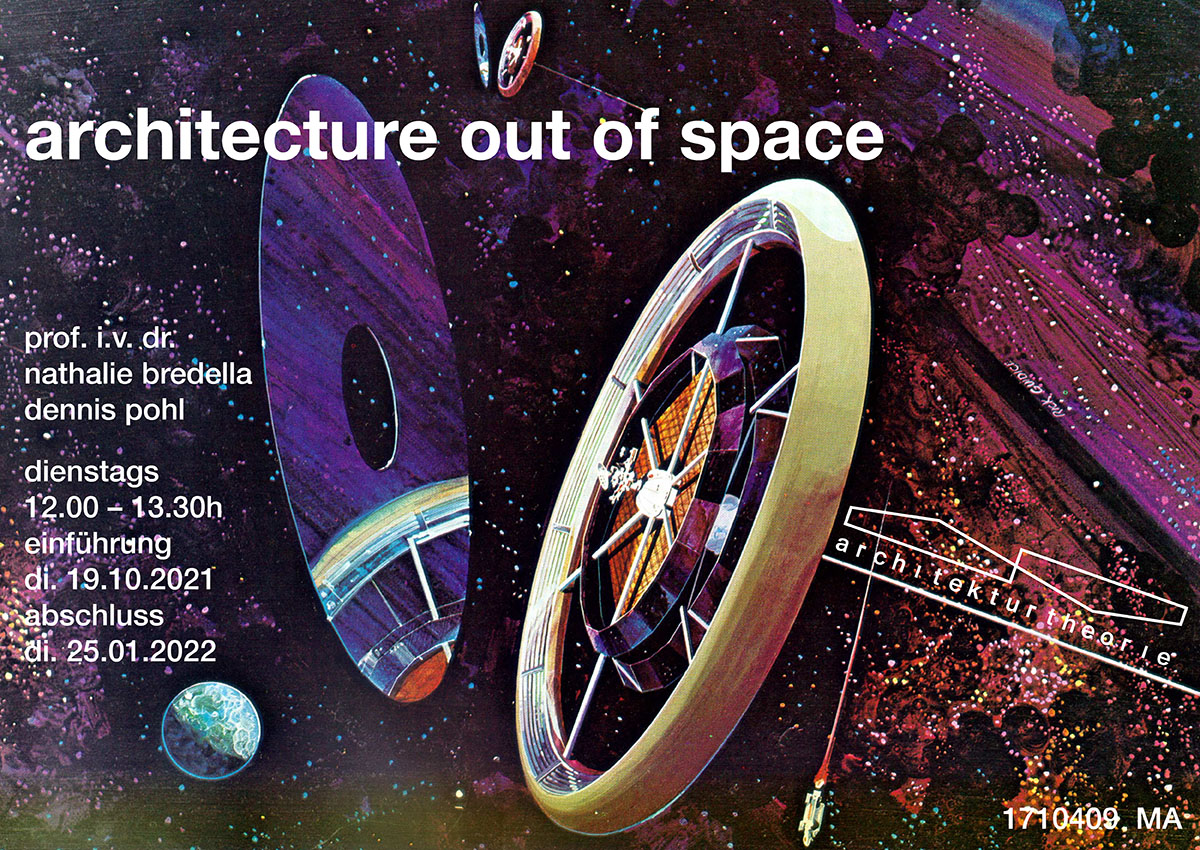
Dennis Pohl
Architektur ist an der Gestaltung des Weltraums maßgeblich beteiligt. Satelliten, Raumkapseln oder Welltraumkolonien sind neben Objekten der Wissenschaft, auch Planung artifizieller Umwelten durch Entwerfer*innen. Diese Entwürfe halten nicht nur Vorstellungen über den Weltraum bereit, als Notausgang, Metapher oder Utopie, sondern vermitteln wie die Erde jeweils ökologisch, technologisch und politisch begriffen wird. Wie lässt sich ein Leben außerhalb der irdischen Bedingungen denken? Ziel des intensiven Lektüre- und Rechercheseminars ist es deshalb, sich anhand von ausgewählten Raumtheorien aus Medien-, Wissenschafts-, und Kunstgeschichte mit den Wechselwirkungen von Architektur und Weltraum auseinanderzusetzen.
DP
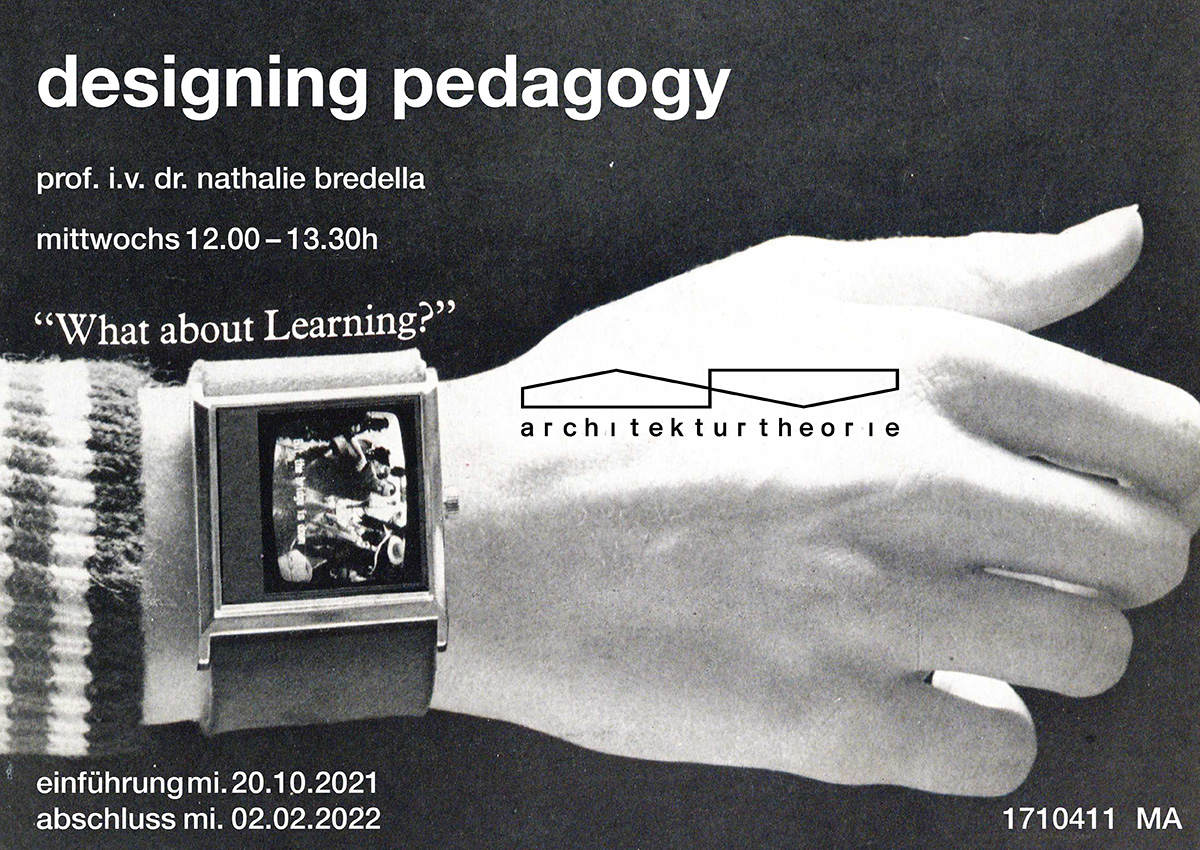
Nathalie Bredella
Mit der Verlagerung der Lehre ins Internet rücken die Wechselbeziehungen zwischen den Infrastrukturen der Universität und Formen der Wissensproduktion in den Blick. Das Seminar widmet sich den räumlich-technischen Organisations- und Kommunikationsformen, die die Produktion und Zirkulation von Wissen bedingen: der Konstellation von Hörsälen, Laboren und Bibliotheken, die sich seit den 1960er Jahren zunehmend mit technischen Netzwerken verschränken. Anhand von Fallstudien und der Lektüre von Forschungsliteratur werden wir erarbeiten, wie die Verschränkung von digitalem und gebautem Raum das Selbstverständnis der Wissenschaften bedingt und Aussagen über zukünftige Medienkonstellationen der Universität birgt.
DG
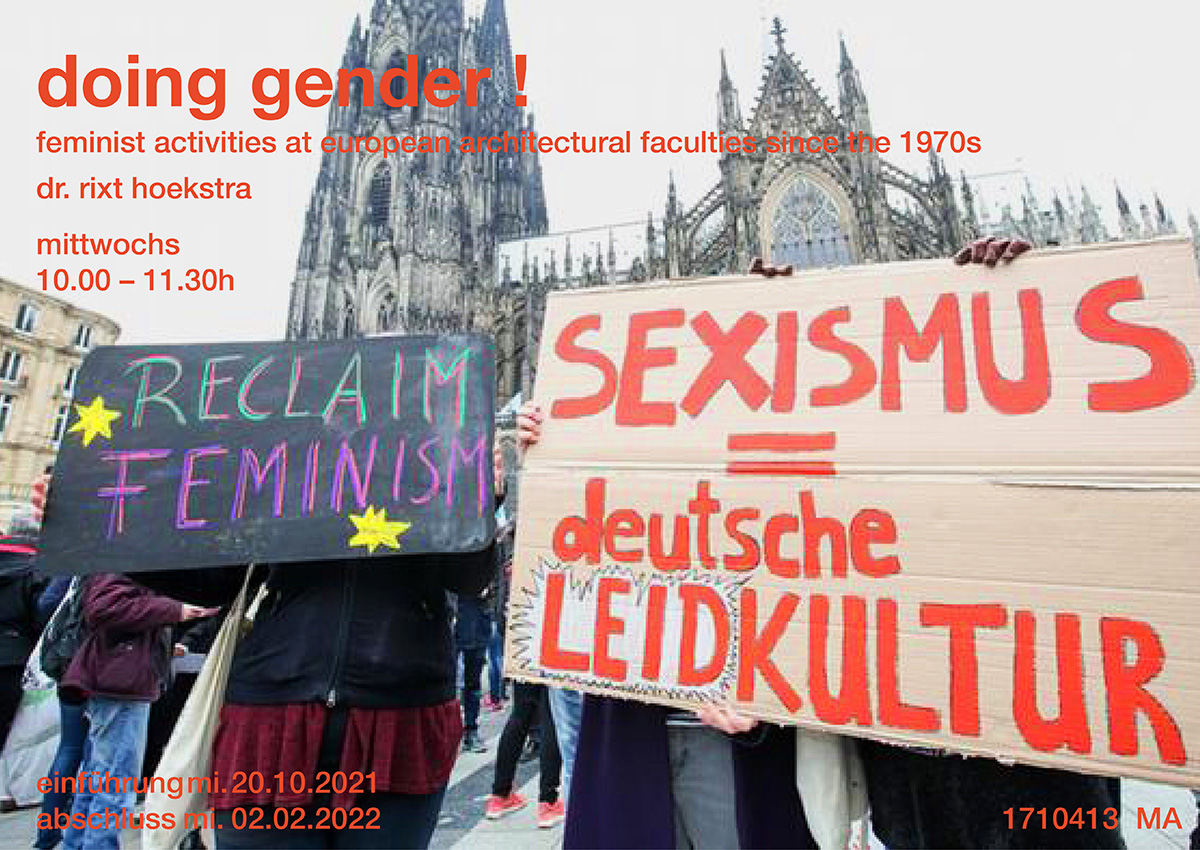
Rixt Hoekstra
Architektur betrifft alle. Doch während auf gesellschaftlicher Ebene die Rufe nach einer fundierten und offenen Debatte um Feminismus, Gender, Race und Class lauter werden, bleiben deutsche Architekturfakultäten (verdächtig) leise. Hier setzt das Seminar an und fragt nach einer Architekturgeschichte feministischer Kritik. Mit Blick auf Formen des Aktivismus fokussieren wir feministische Bewegungen in den Niederlanden und Deutschland, die die Standards des Massenwohnungsbaus der 1980er Jahre kritisierten: wir besuchen Archive in Berlin, Karlsruhe und Rotterdam, werden Interviews führen und fragen, was „doing gender“ heute bedeutet.
AD
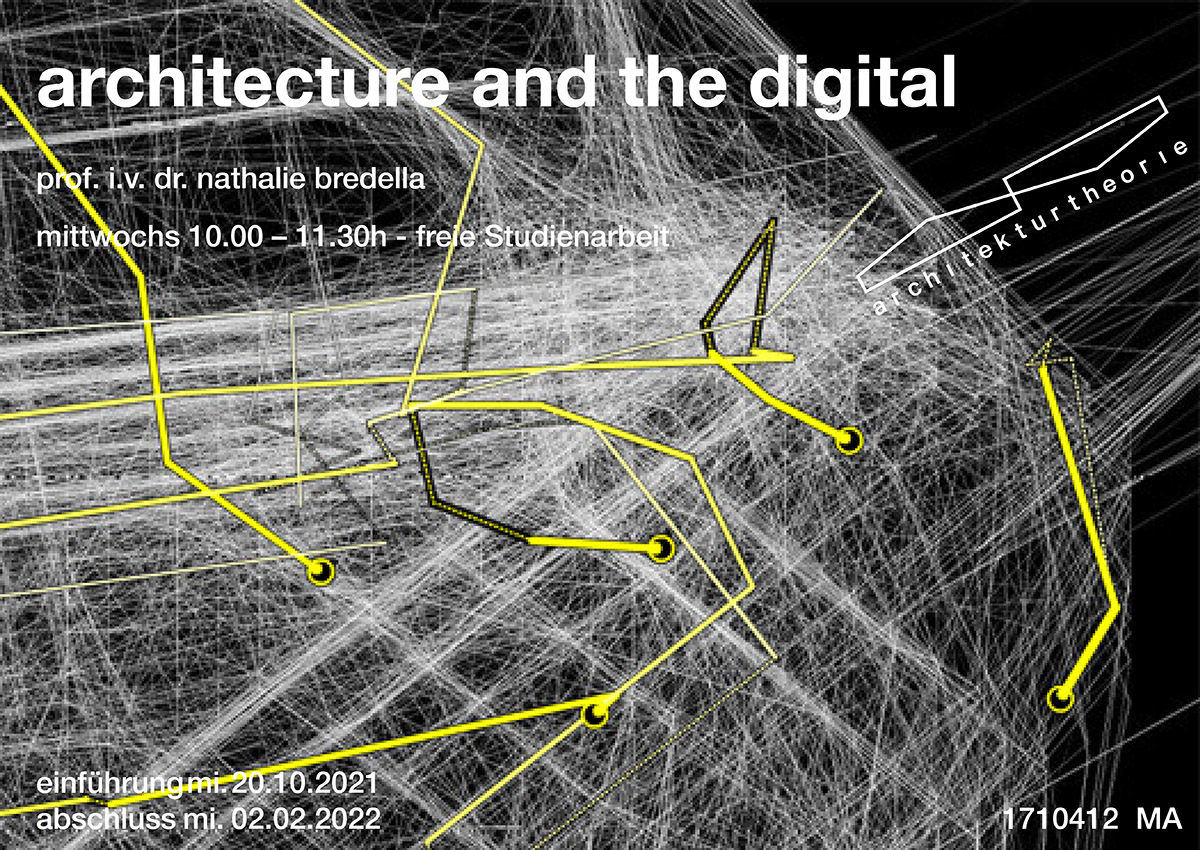
Nathalie Bredella
Das Forschungsseminar widmet sich ausgewählten Themen im Bereich Architektur und Digitalität. Die Reflexion über die Werkzeuge und Materialität computerbasierter Entwurfsprozesse steht im Fokus der Betrachtung sowie ihre historische Situierung.
AGG
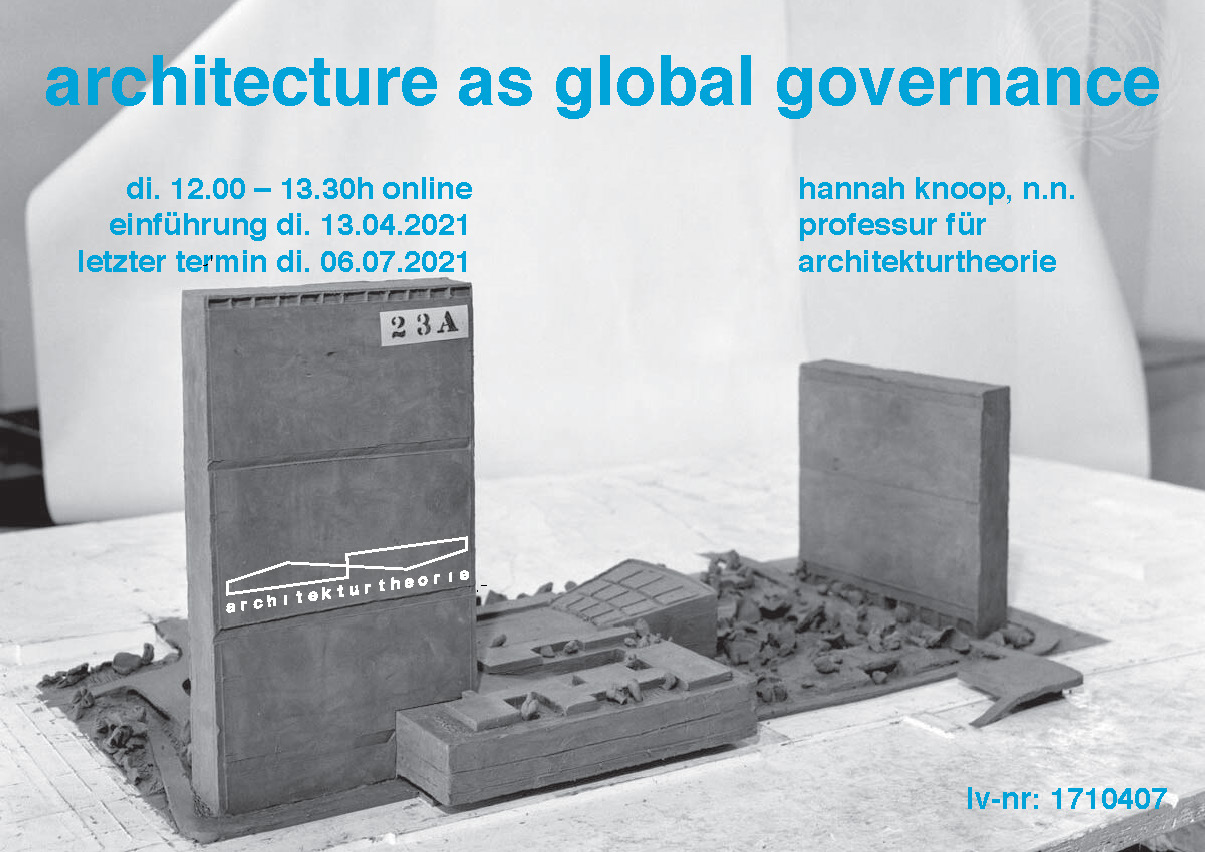
Hannah Knoop
Architektur formt die globale Gesellschaft. Der Völkerbundpalast in Genf und das Headquarter der UNO in New York sind nicht nur Architekturikonen, sondern auch Symbole einer Weltgemeinschaft. Doch die UNO ist in einer Krise: sie muss sich in einer planetarischen Gesellschaft behaupten und gegenüber Nationalismen und Populismus durchsetzen. Wie lassen sich die transnationalen politischen Bestrebungen heute auch architektonisch repräsentieren? Was bedeutet es, für eine globale Weltgemeinschaft im Umbruch zu entwerfen?
Die Veranstaltung ist als Lektüre- und Rechercheseminar konzipiert. Ziel ist es, sich mit den Ästhetiken der globalen Architektur auseinanderzusetzen, um Macht und Ohnmacht einer Architektur als Global Governance zu ergründen.
ADK
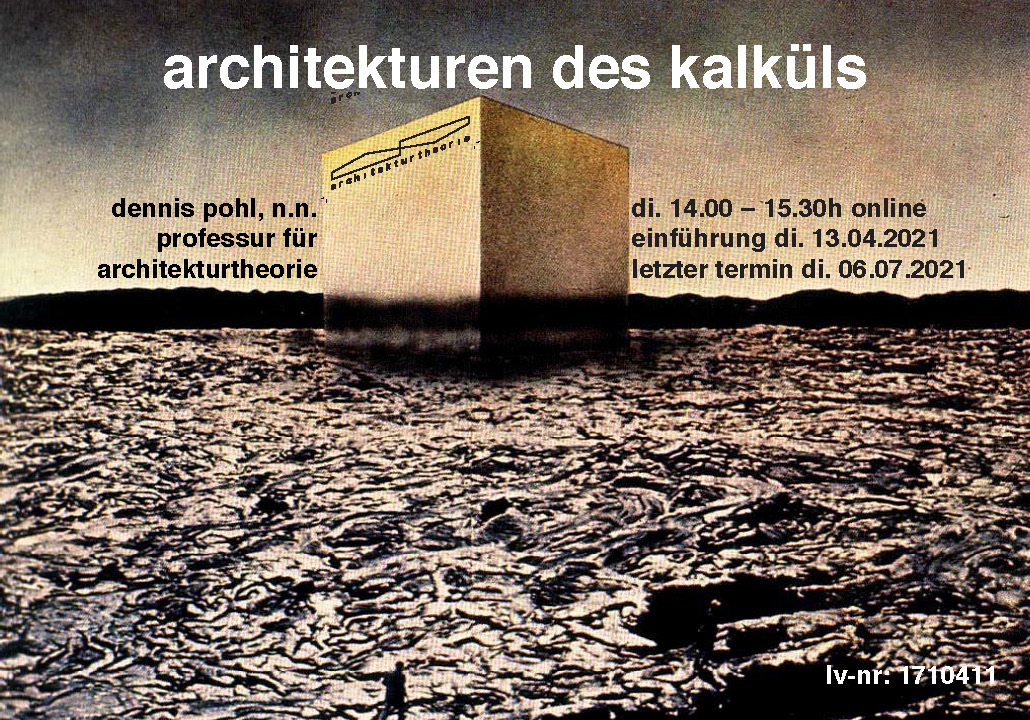
Dennis Pohl
Die Serverfarmen in denen der Alltag errechnet wird sind gegenwärtig nicht mehr weg zu denken. Doch die Orte des Rechnens haben eine eigene Architekturgeschichte, die noch nicht hinreichend erschlossen ist. Vom Rechnungshof bis hin zum Rechenzentrum – keine Rechnung geht ohne die Räume auf, in denen sich mathematische Operationen vollziehen. Das Seminar erforscht die Orte des Rechnens und befragt sie, wie darin soziale Verhältnisse kalkuliert werden. Was zeichnet diese Typologien aus? In welcher Wechselwirkung stehen sie zum Berechneten?
Die Veranstaltung ist als Lektüre- und Rechercheseminar konzipiert. Ziel ist es, sich mit Architekturen des Rechnens auseinanderzusetzen und diese mittels Lektüre aus den Medientheorien zu ergründen.
DAZ
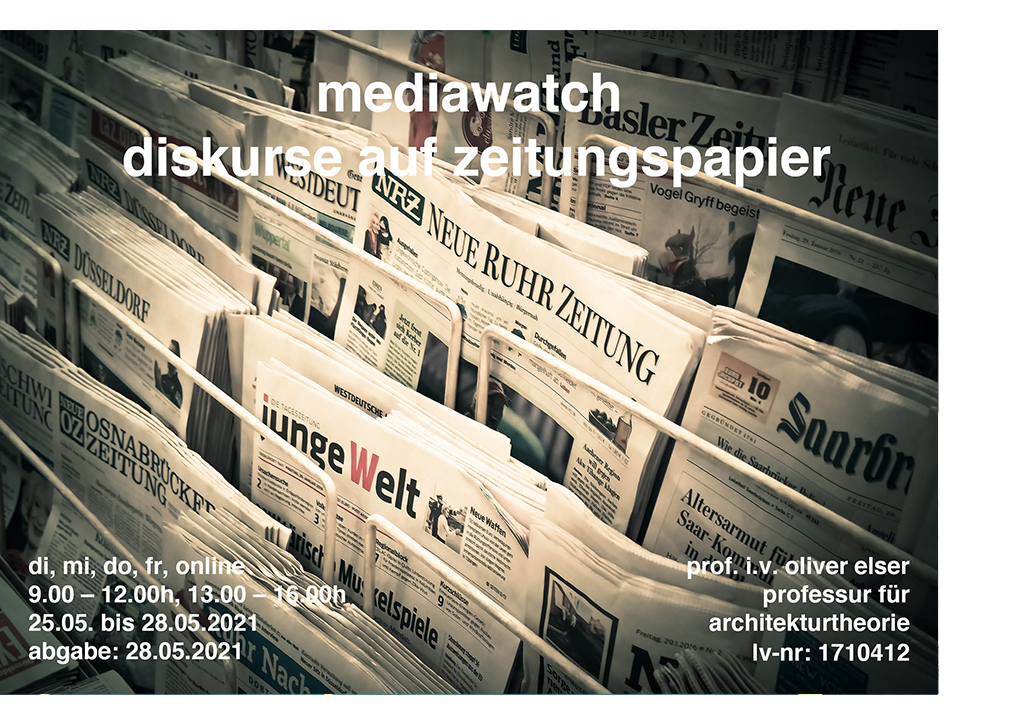
Oliver Elser
Was hat eine größere Wirkung auf die Architektur: Die Diskussion über die Pendlerpauschale? Ein engagierter Artikel im Feuilleton? Oder die Reaktionen auf die Hausbesetzerbewegung?
In dem 4-tägigen Blockseminar erschließen wir uns die Relevanz von Architekturdiskursen durch gemeinsame Zeitungslektüre, leider pandemiebedingt nur in Online-Archiven. Der Bezugsrahmen sind die 1970er Jahre, eine Zeit des Umbruchs. Kritik am Massenwohnungsbau, die Neubewertung des Altbaubestandes durch eine breite Protestbewegung, die ersten Anzeichen der Ökologiebewegung: All das verfolgen wir in Zeitungsarchiven. Ziele sind: 1. Gemeinsame Erstellung einer Sammlung von Leitbegriffen, 2. Auffinden von Schlüsseltexten und 3. kurze Einordnung der Schlüsseltexte.
AOT
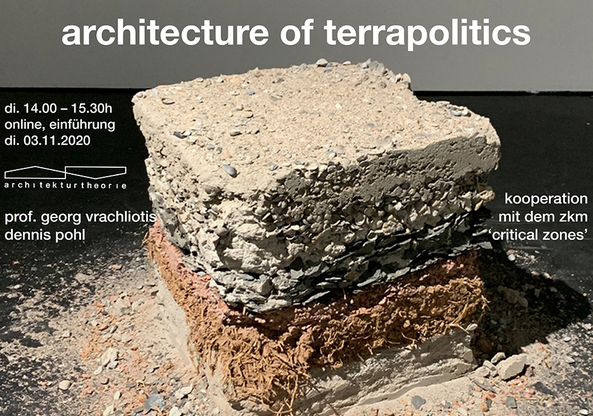
Dennis Pohl, Georg Vrachliotis
Architektur formt unsere Erde. Wie Gebäude weltweit hergestellt und gebaut werden, ist ein Prozess, der nicht mehr nur an der Erdoberfläche stattfindet. Die Erde wird längst digital neu vermessen, um Sandstein, Eisen, Kupfer oder Lithium durch aufwendige Verfahren abzubauen und für die Bauindustrie aufzubereiten. Rohstoffe werden zu einem politisch umkämpften geologischen Kapital der globalen Architektur. Doch wie hängen Bauen, Rohstoffe und Digitalisierung zusammen? Und was ist der geologische Fußabdruck der Architekturproduktion?
Die Veranstaltung ist als Lektüre- und Rechercheseminar konzipiert. Ziel ist es, sich mit Raum-, Material-, und Medientheorien aktueller Ökologiediskurse auseinanderzusetzen.
TDC
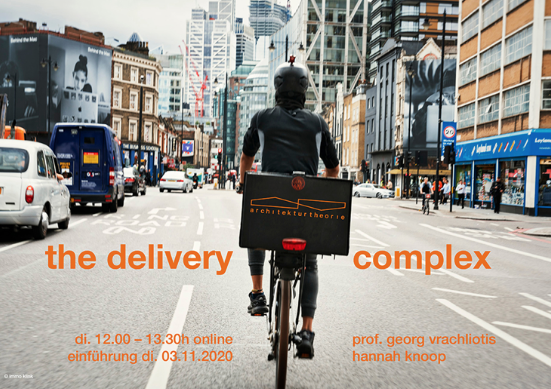
Hannah Knoop, Georg Vrachliotis
Alles scheint lieferbar: ob Bücher von Amazon, Schuhe von Zalando oder das Menü von Deliveroo. Dinge und Lebensmittel werden bestellt und bis an die Haustür geliefert. Waren, Kapital, Plattformen und Menschen verschmelzen zu einer digitalen Superstruktur, in der sich Wünsche in Bestellungen verwandeln: “The Delivery Complex”. Welche Auswirkungen hat das auf Stadt und Architektur? Und was bedeutet es, für eine solche Dienstleistungsgesellschaft zu entwerfen?
Die Veranstaltung ist als Lektüre- und Rechercheseminar konzipiert. Ziel ist es, sich mit interdisziplinären Raum- und Zeittheorien auseinanderzusetzen, um einen neuen Blick auf die Folgen der digitalen Dienstleistungsgesellschaft zu werfen.
SCA
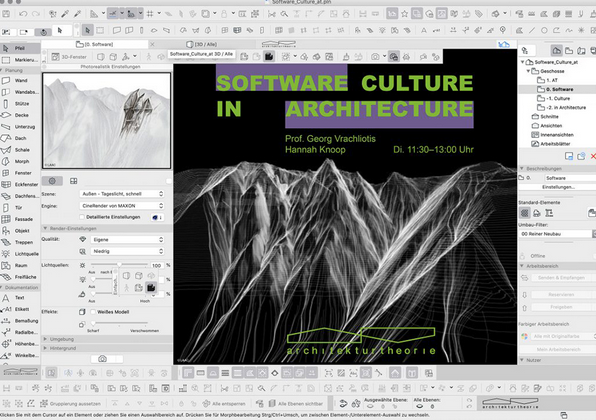
Hannah Knoop, Georg Vrachliotis
Software bestimmt die Architekturproduktion — ob als Entwurfswerkzeuge, Methoden des Renderings und der Simulation, über Verfahren der digitalen Fabrikation bis zur Verwaltung und Optimierung komplexer Bauprozesse. Software gilt es deshalb in der Architektur als ein kulturelles Kollektivphänomen des world design zu begreifen, bei dem weniger das technische Wissen als eine kritische Auseinandersetzung mit dem gestalterischen, künstlerischen und politischen Potential im Vordergrund steht.
Die Veranstaltung ist als Lektüre– und Rechercheseminar konzipiert. Ziel ist es, einen kritischen Blick auf die Kulturgeschichte aktueller Software in der Architektur zu werfen und nach der Handlungsmacht von digitalen Entwurfswerkzeugen zu fragen.
